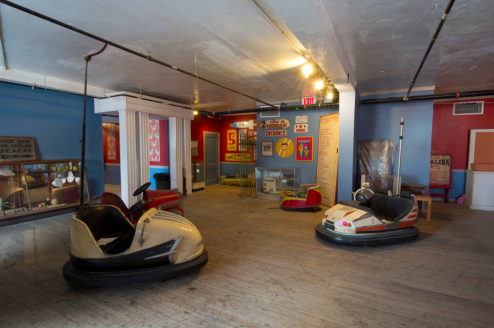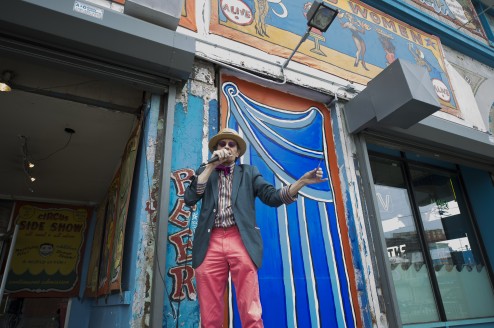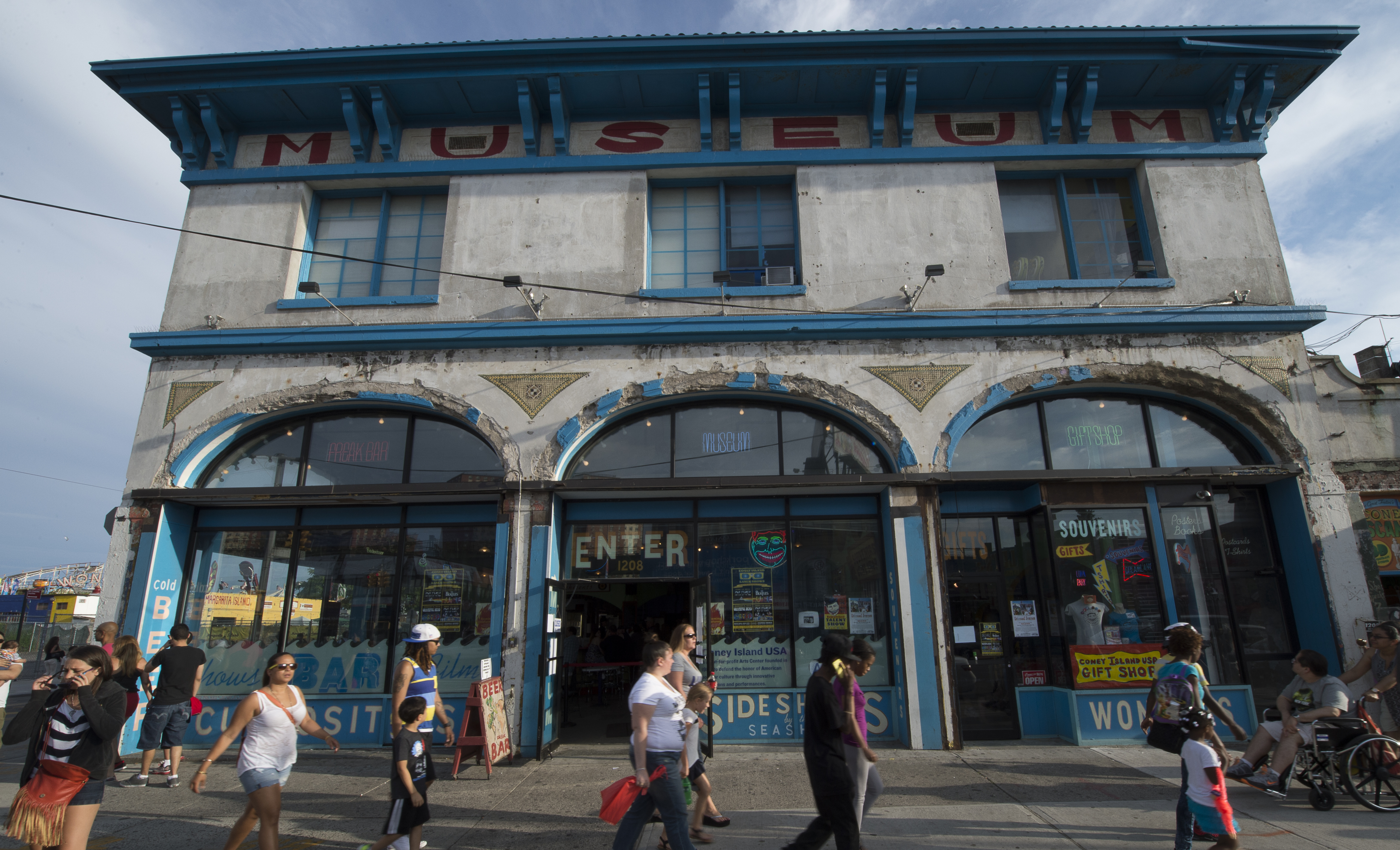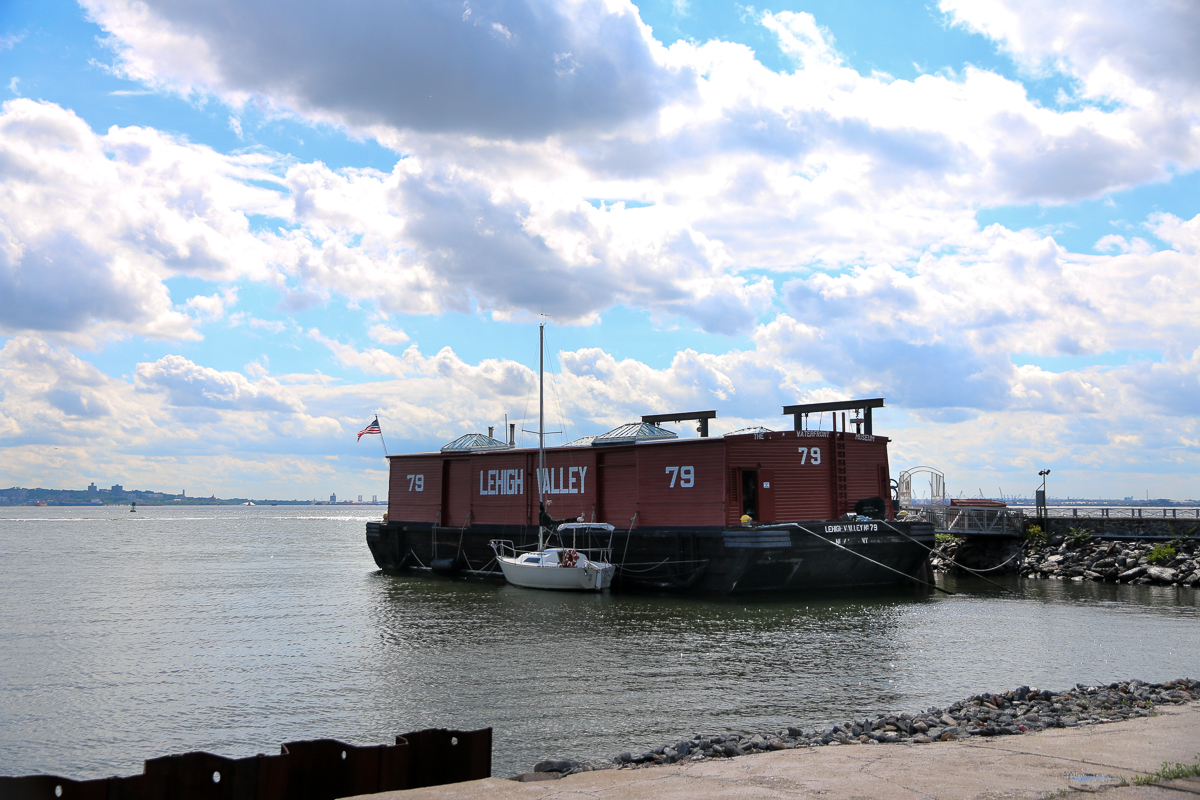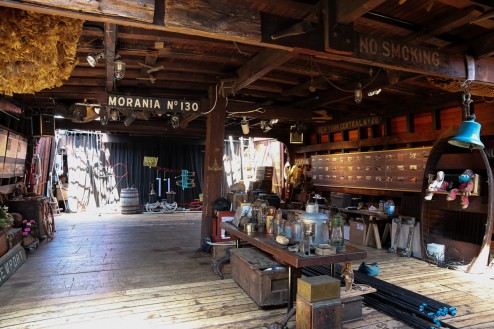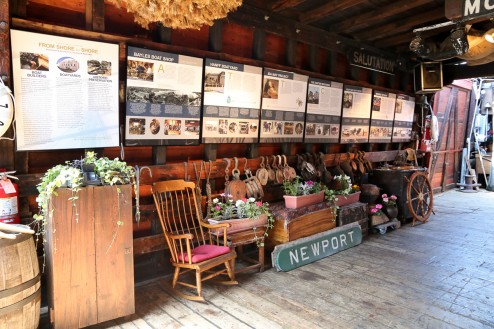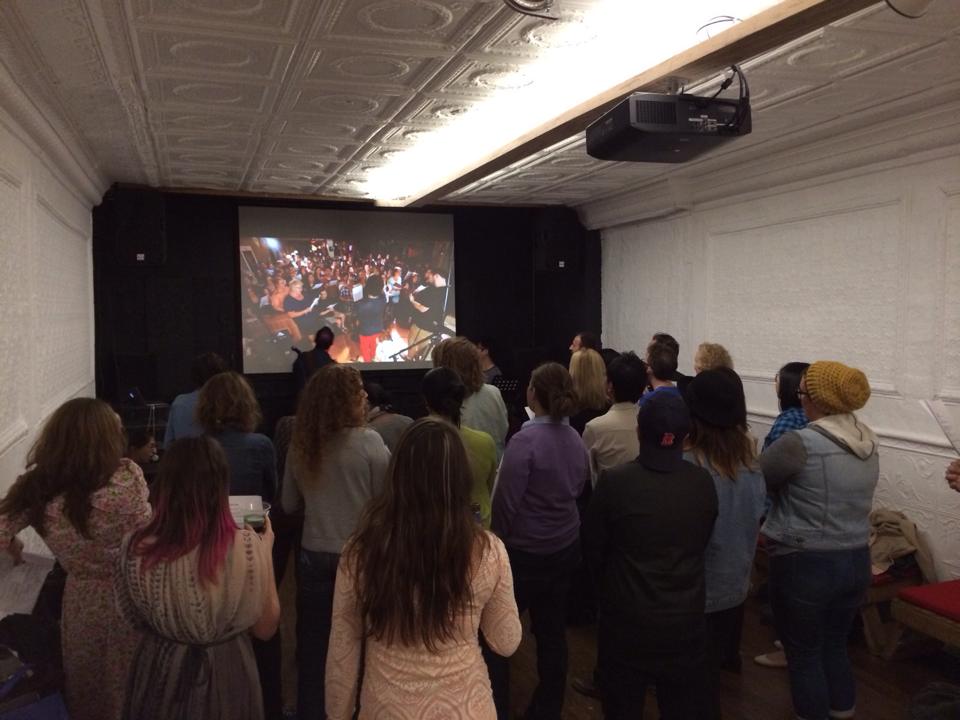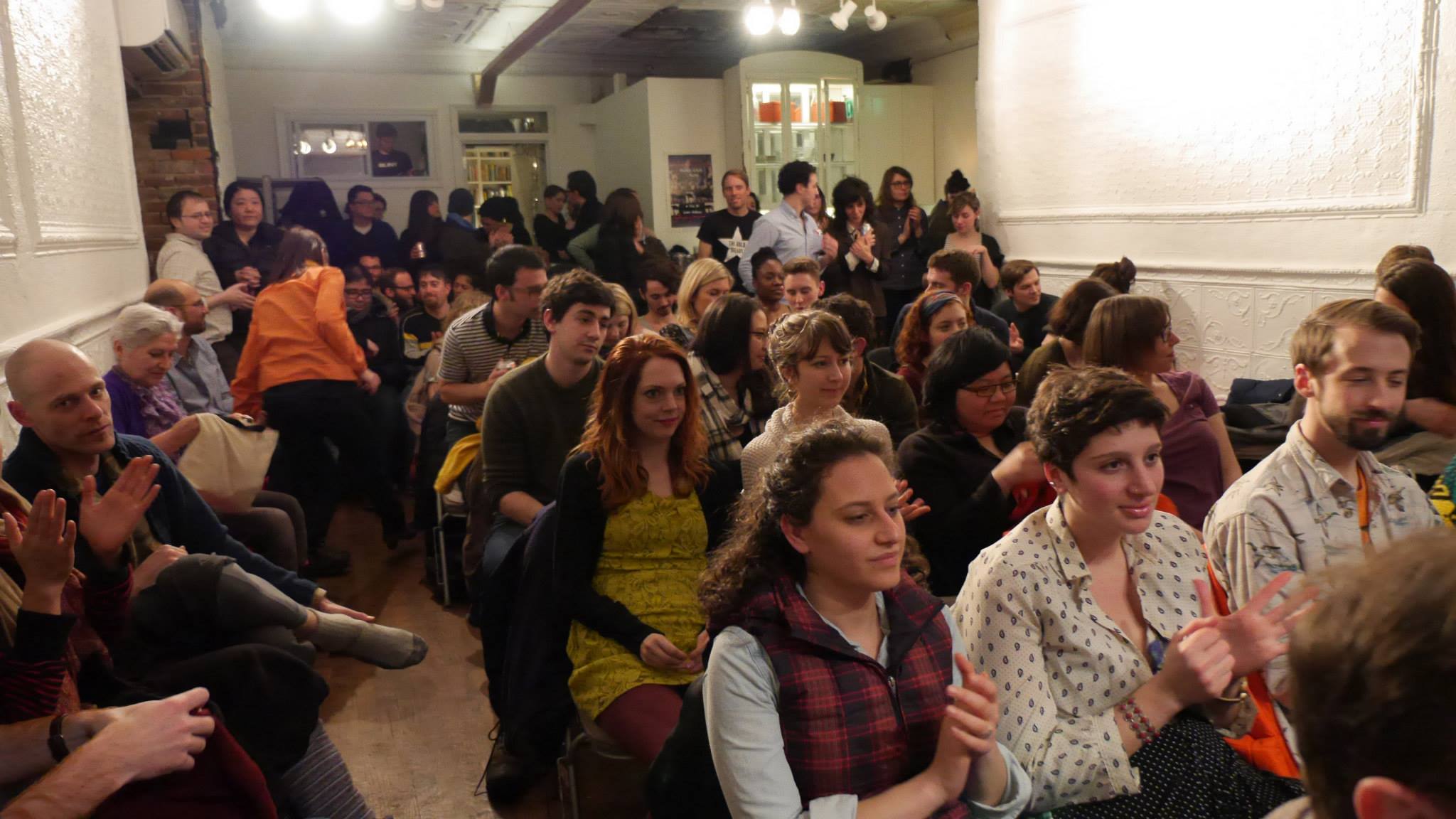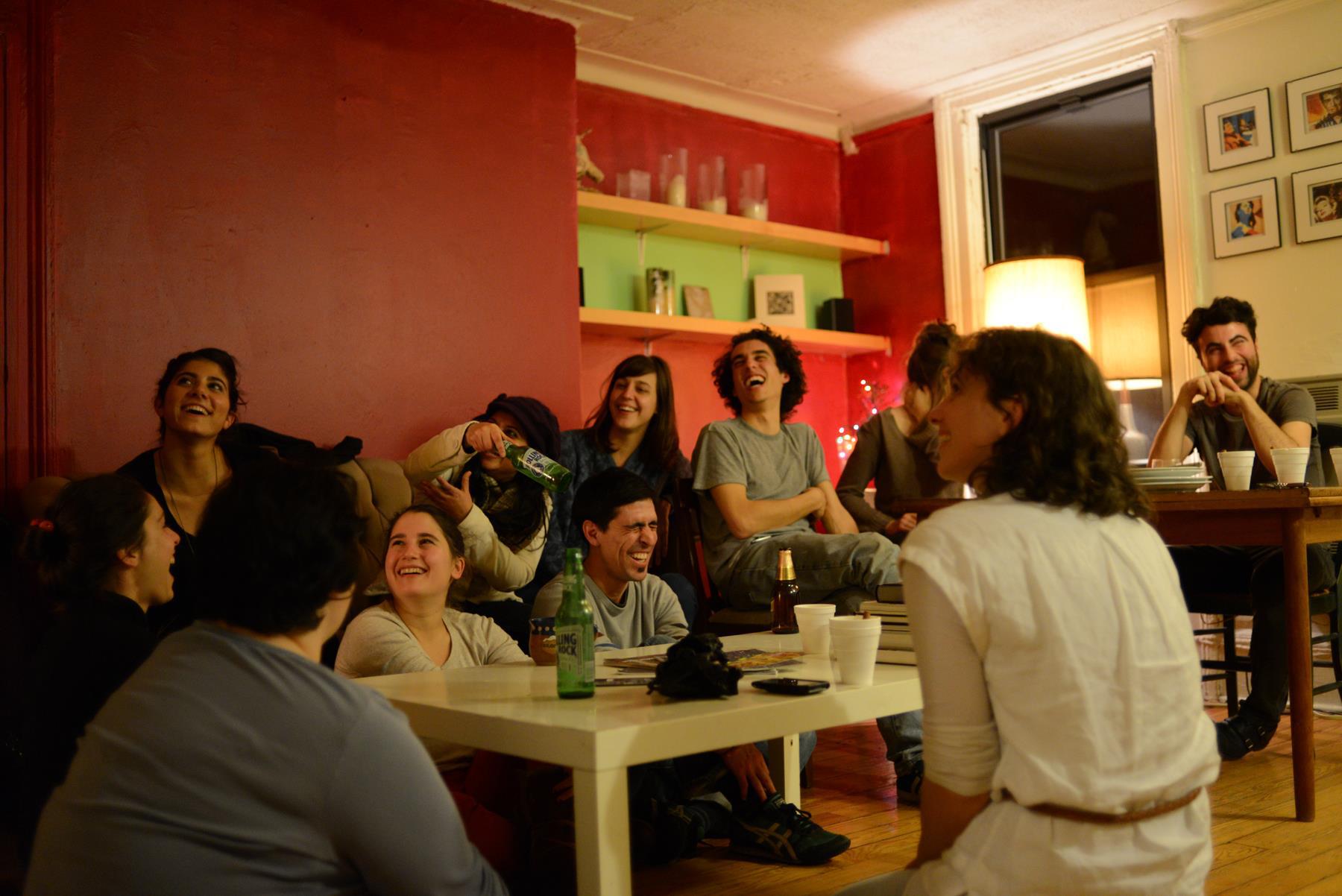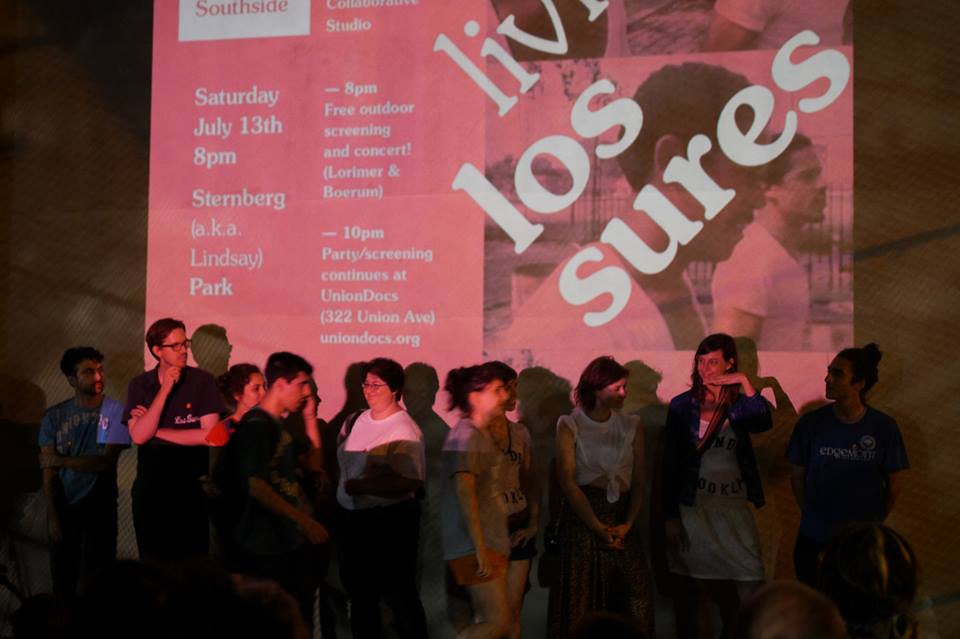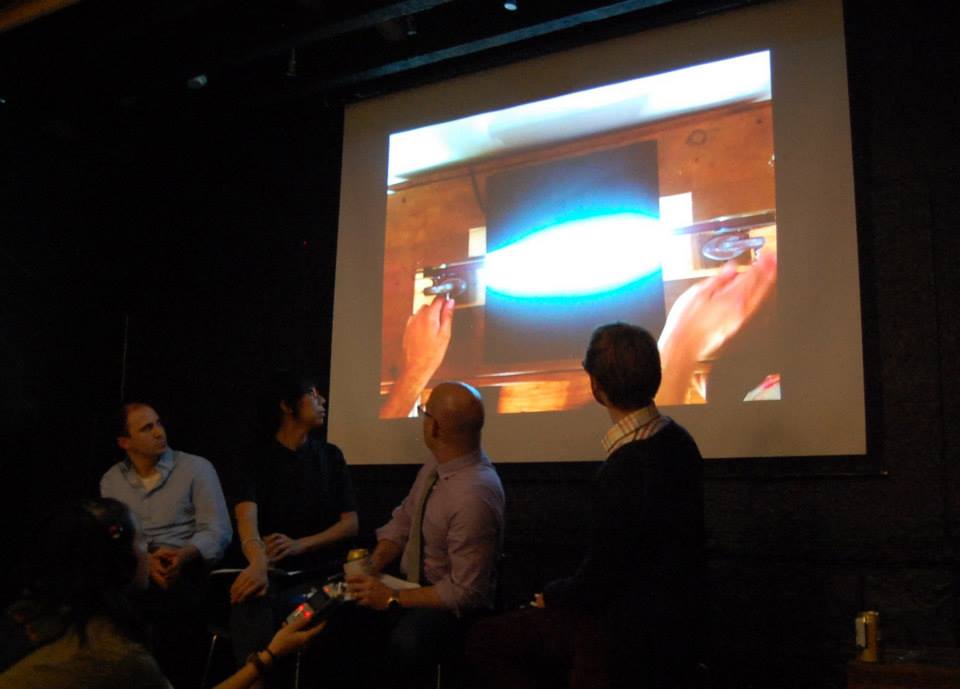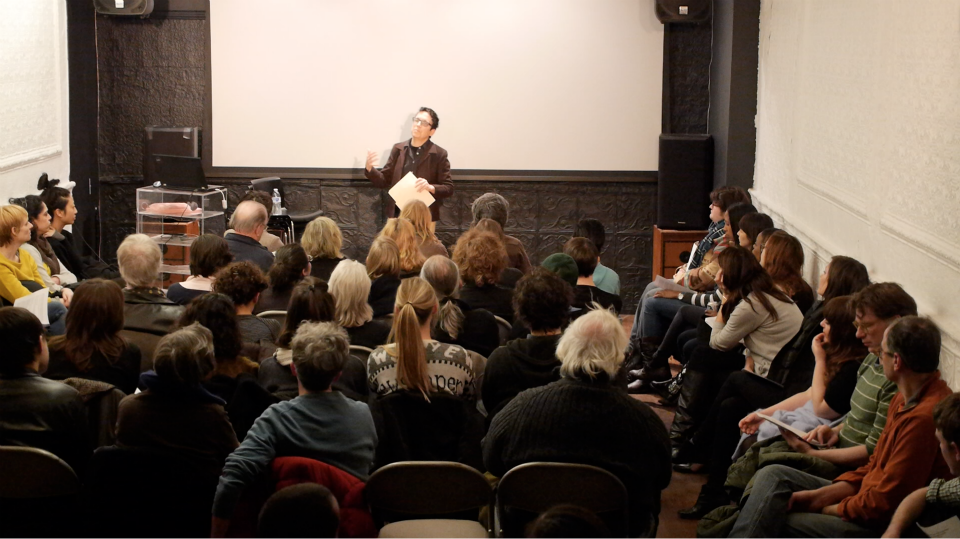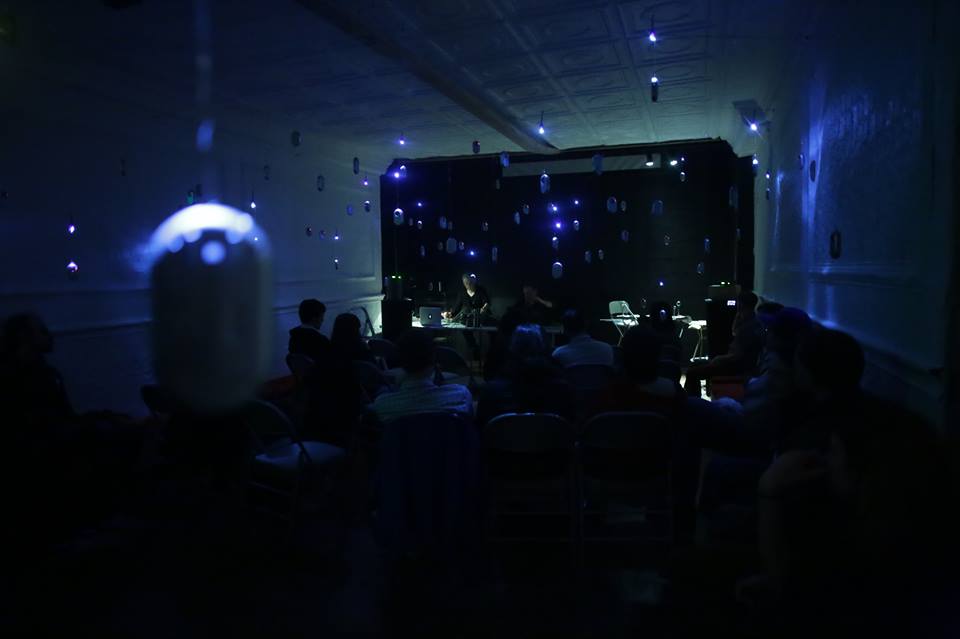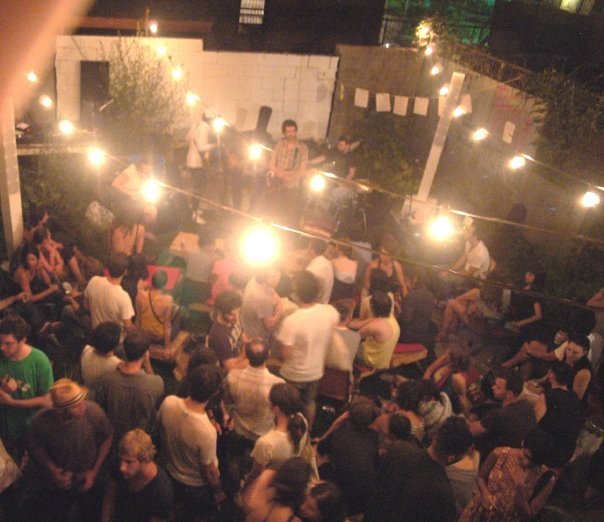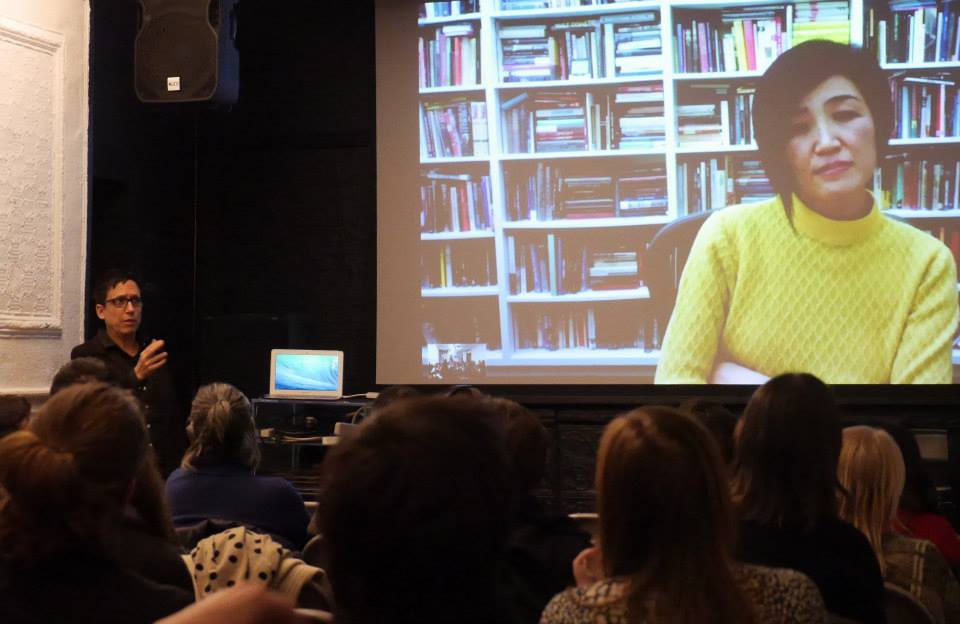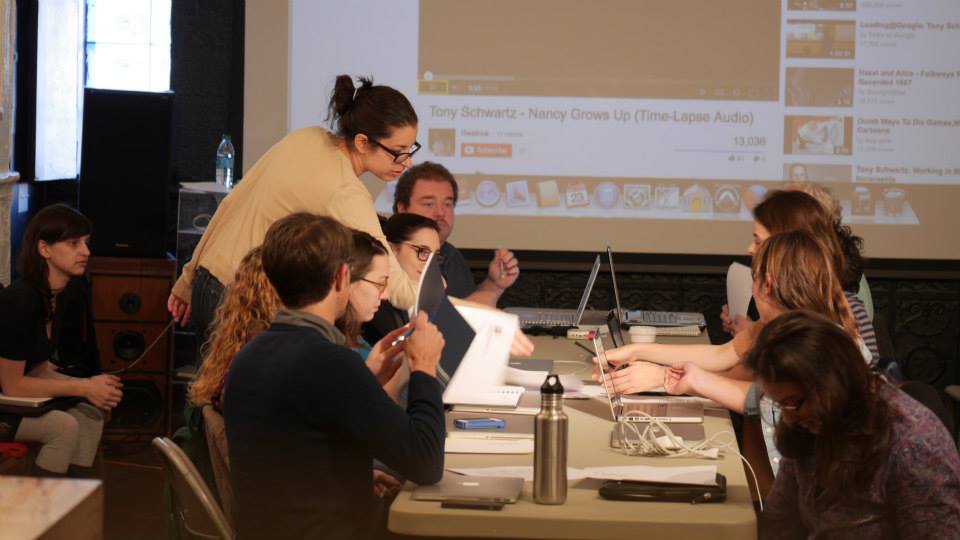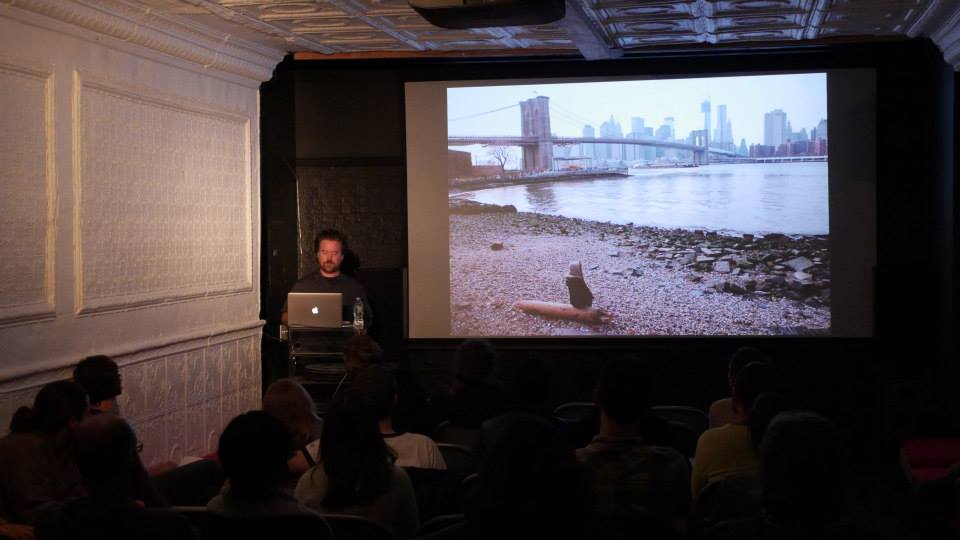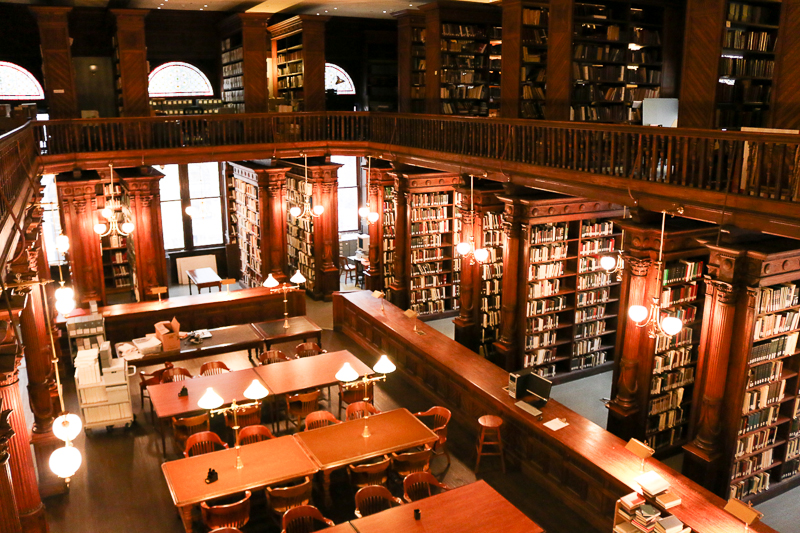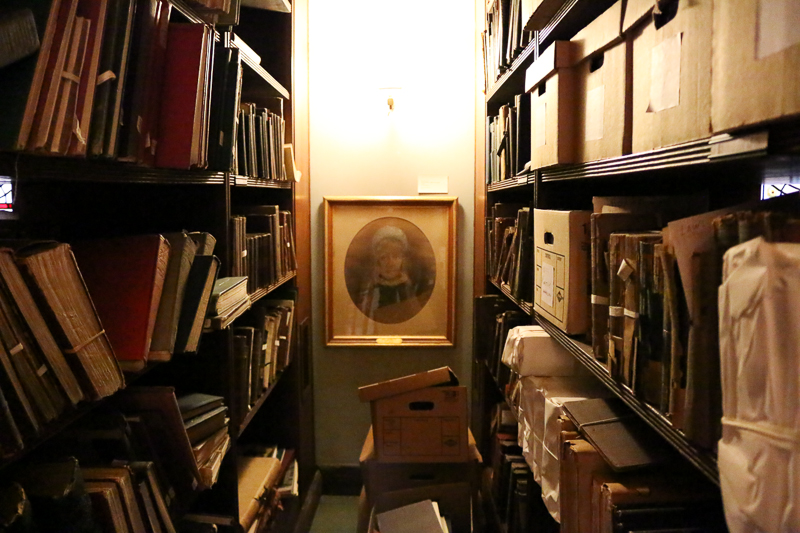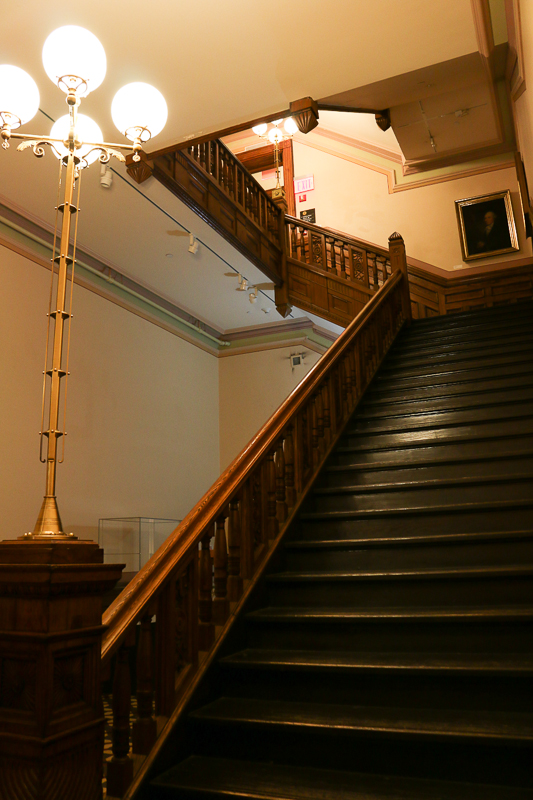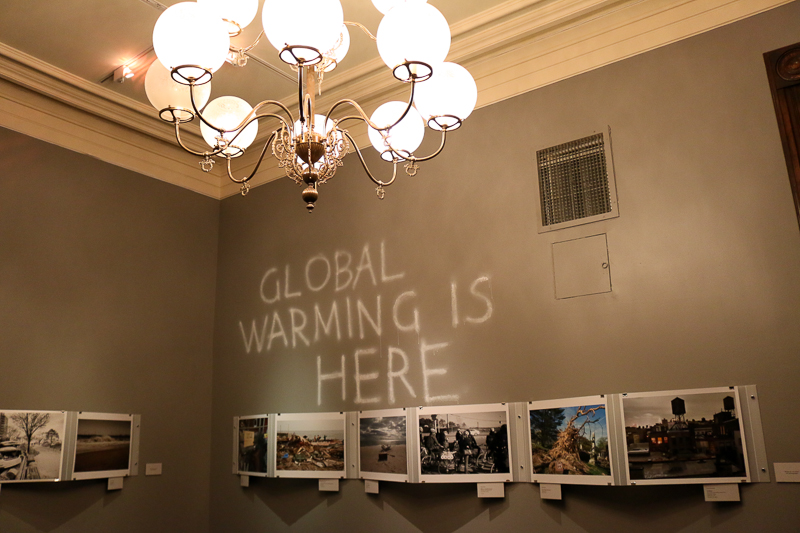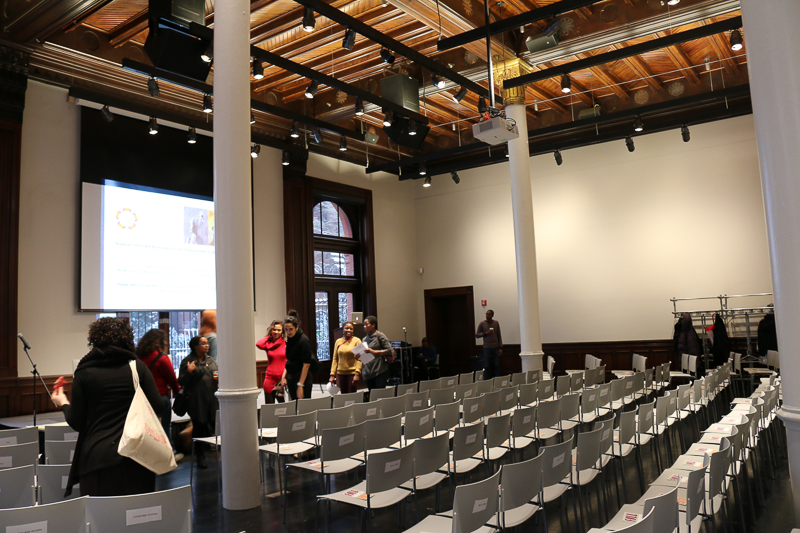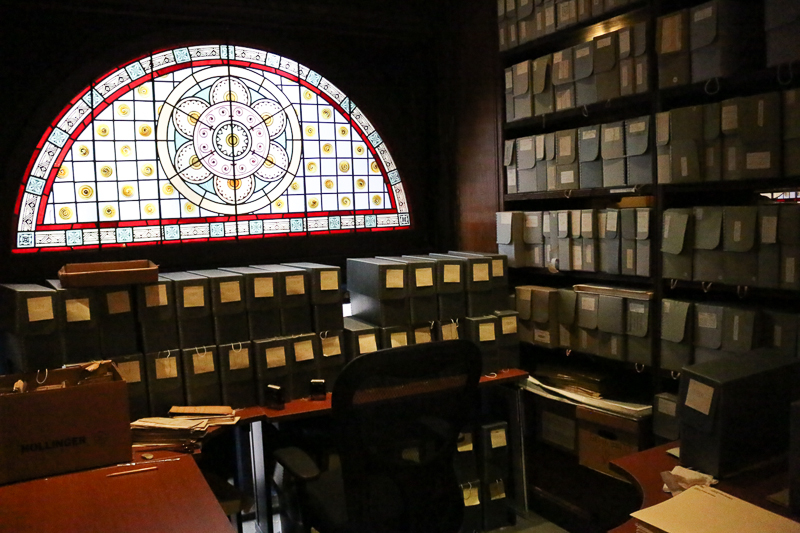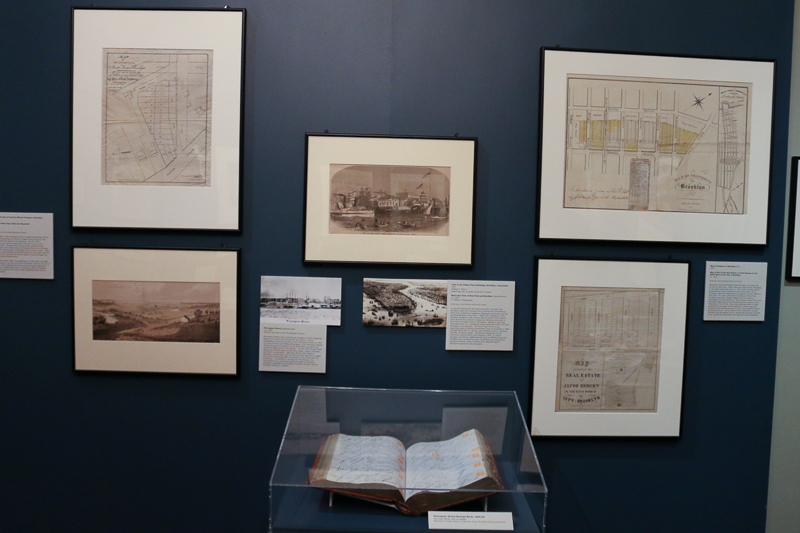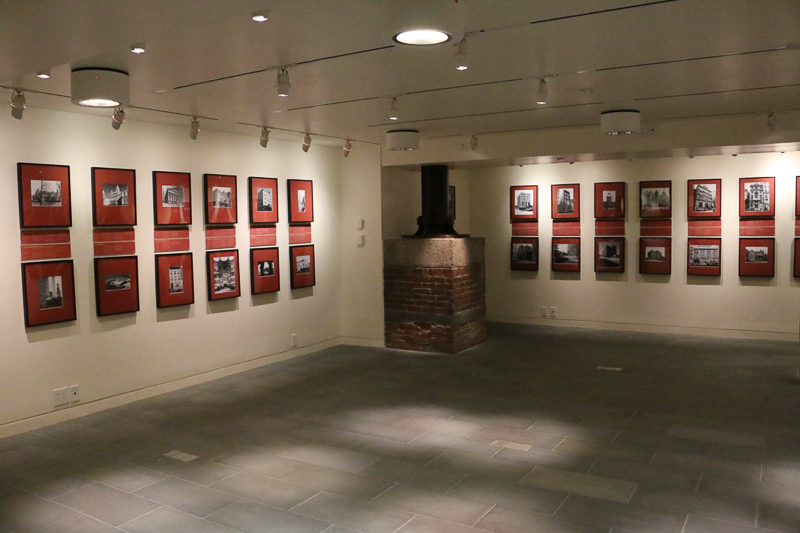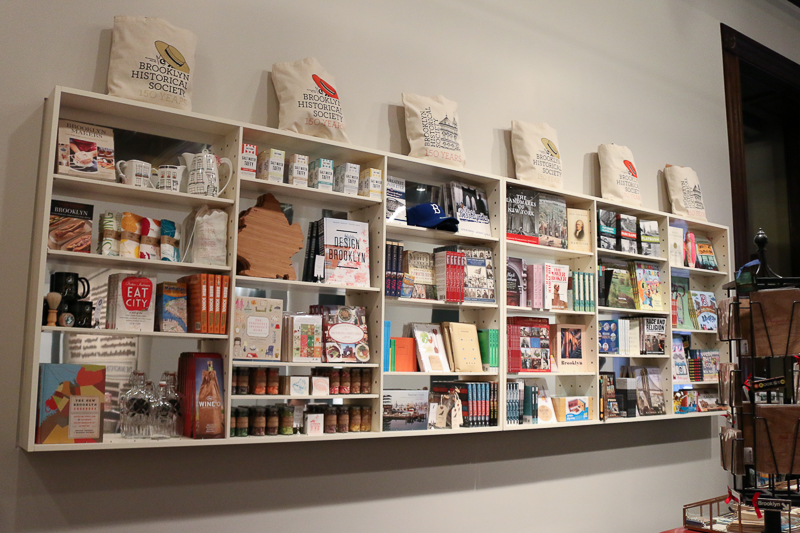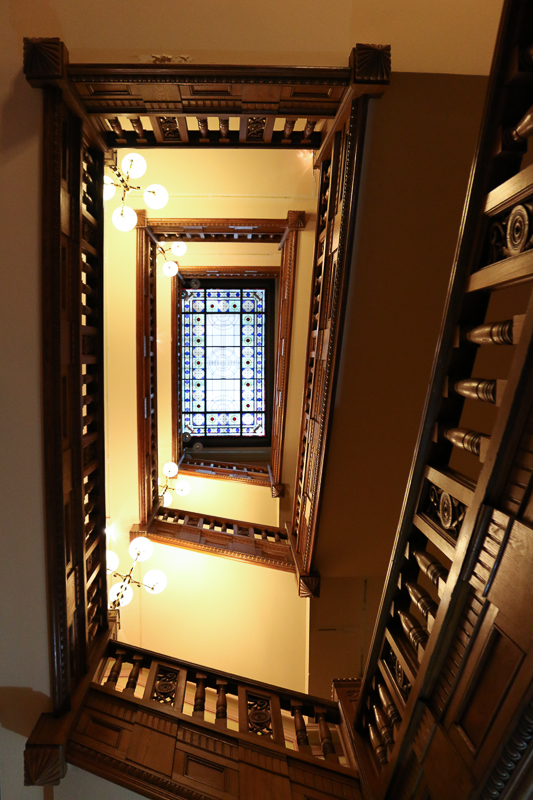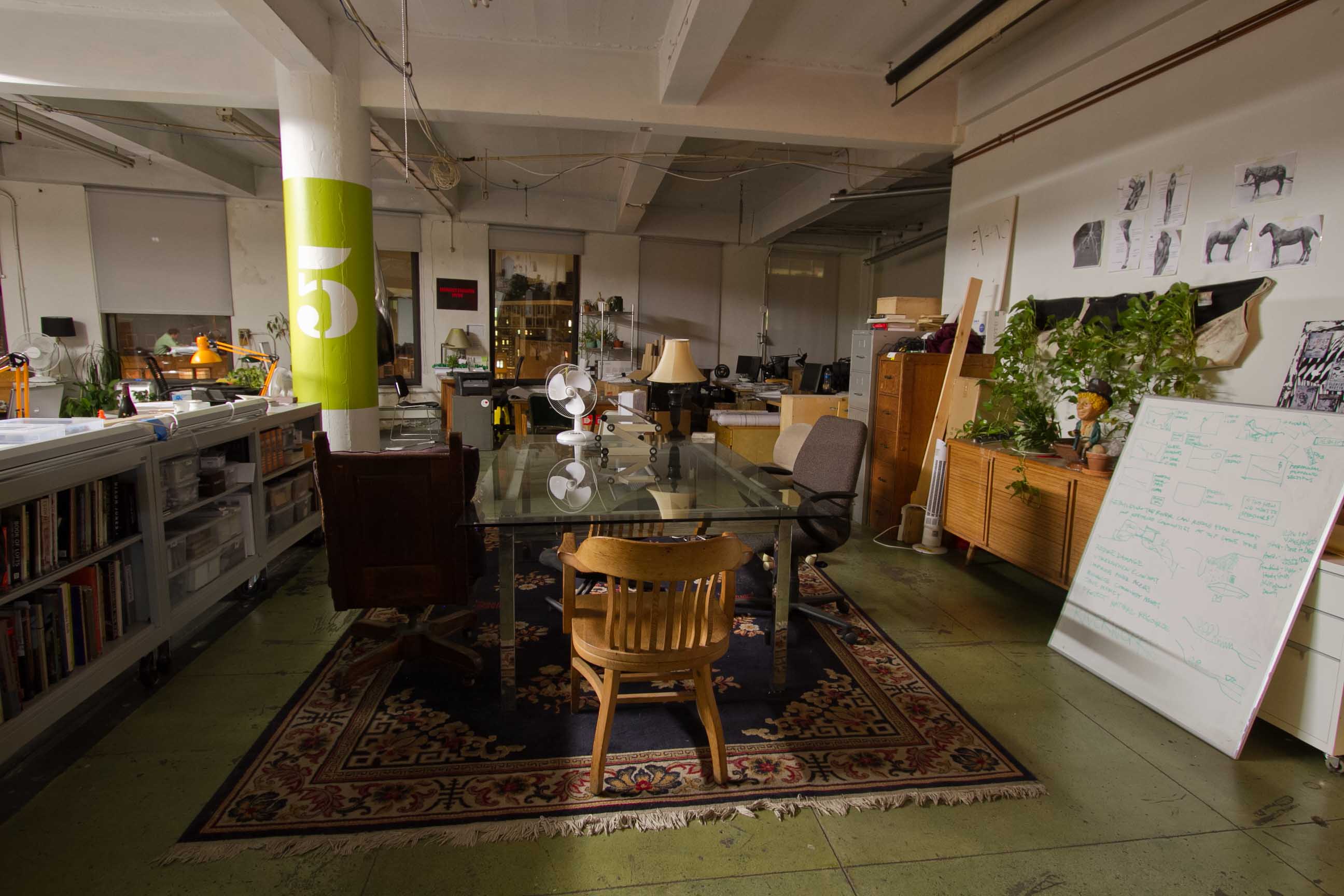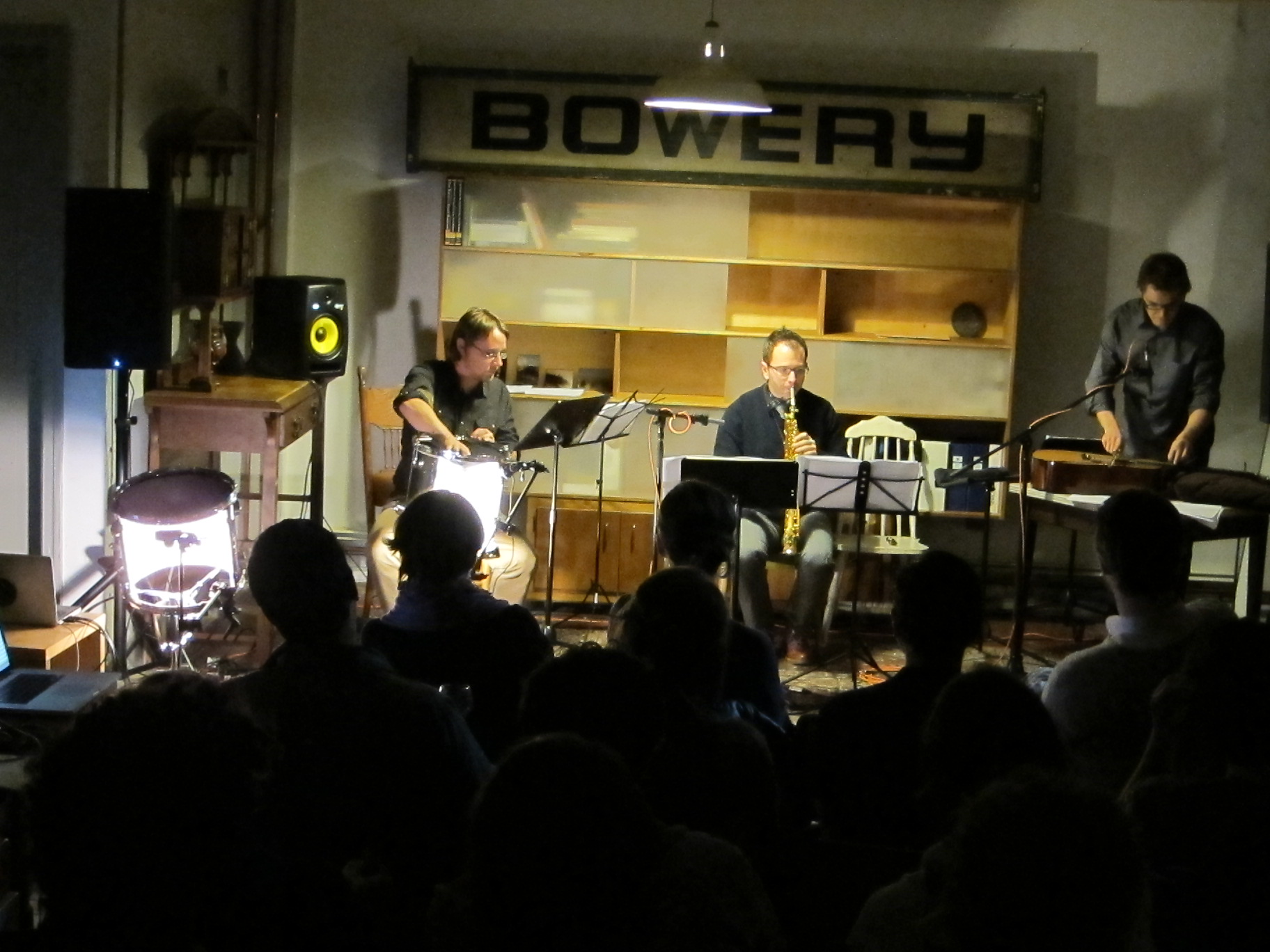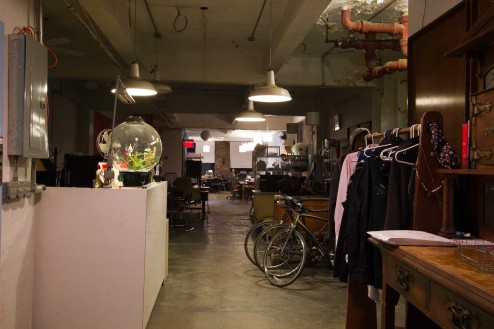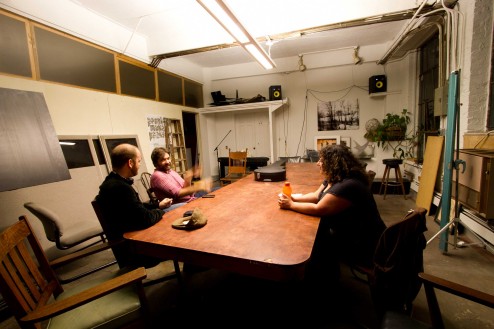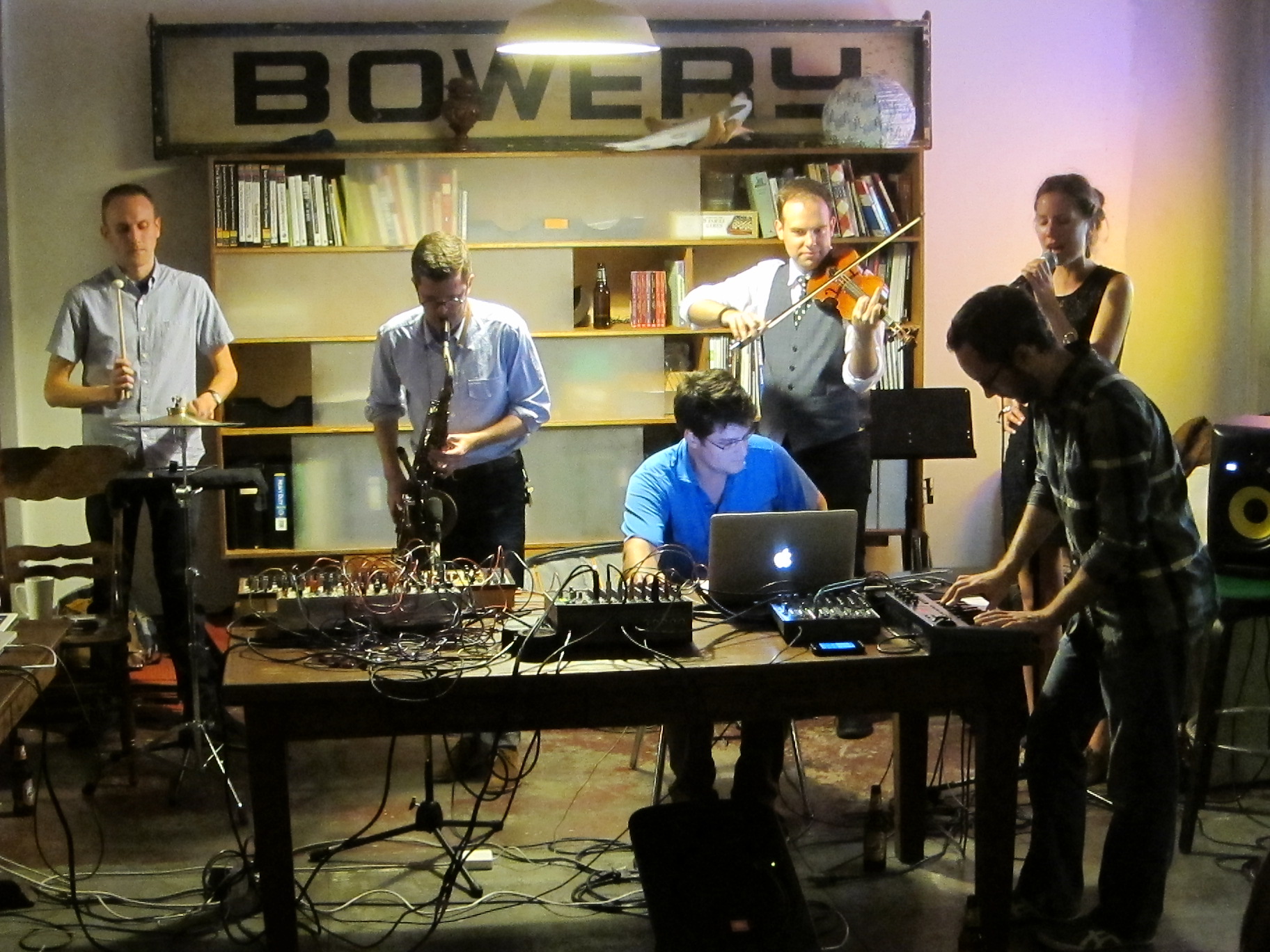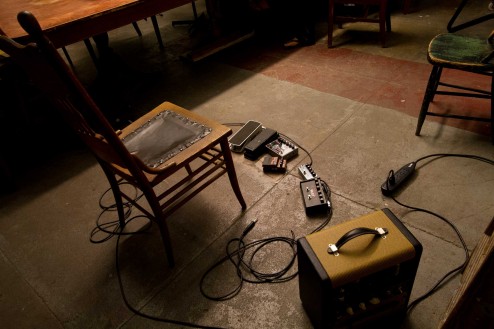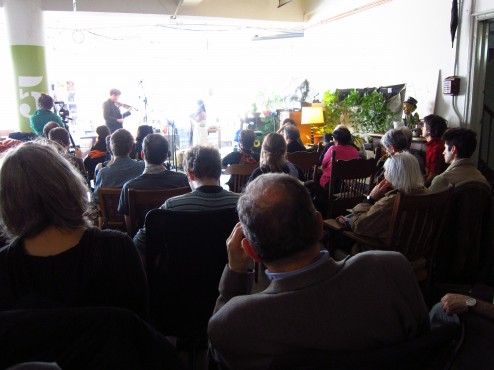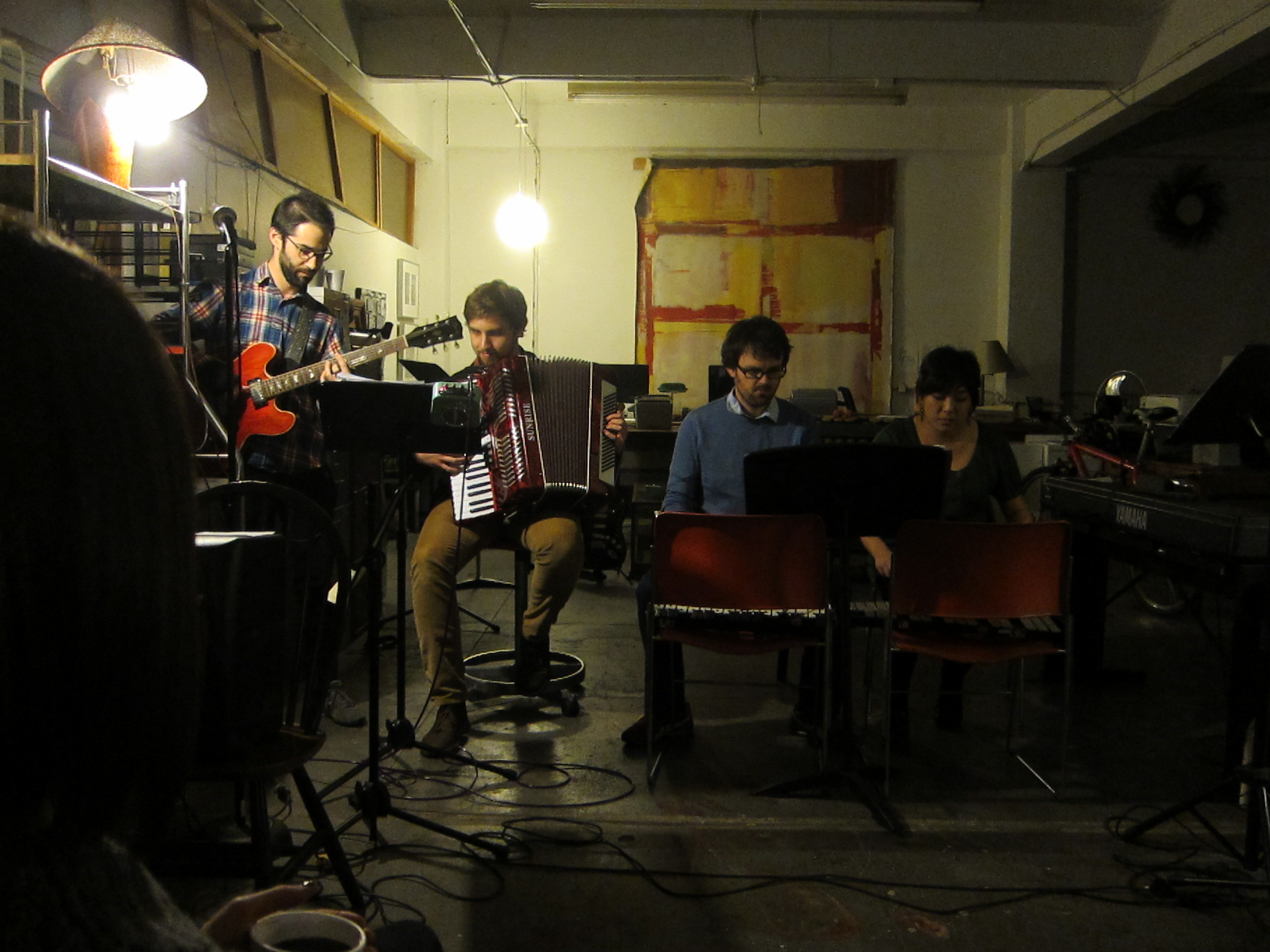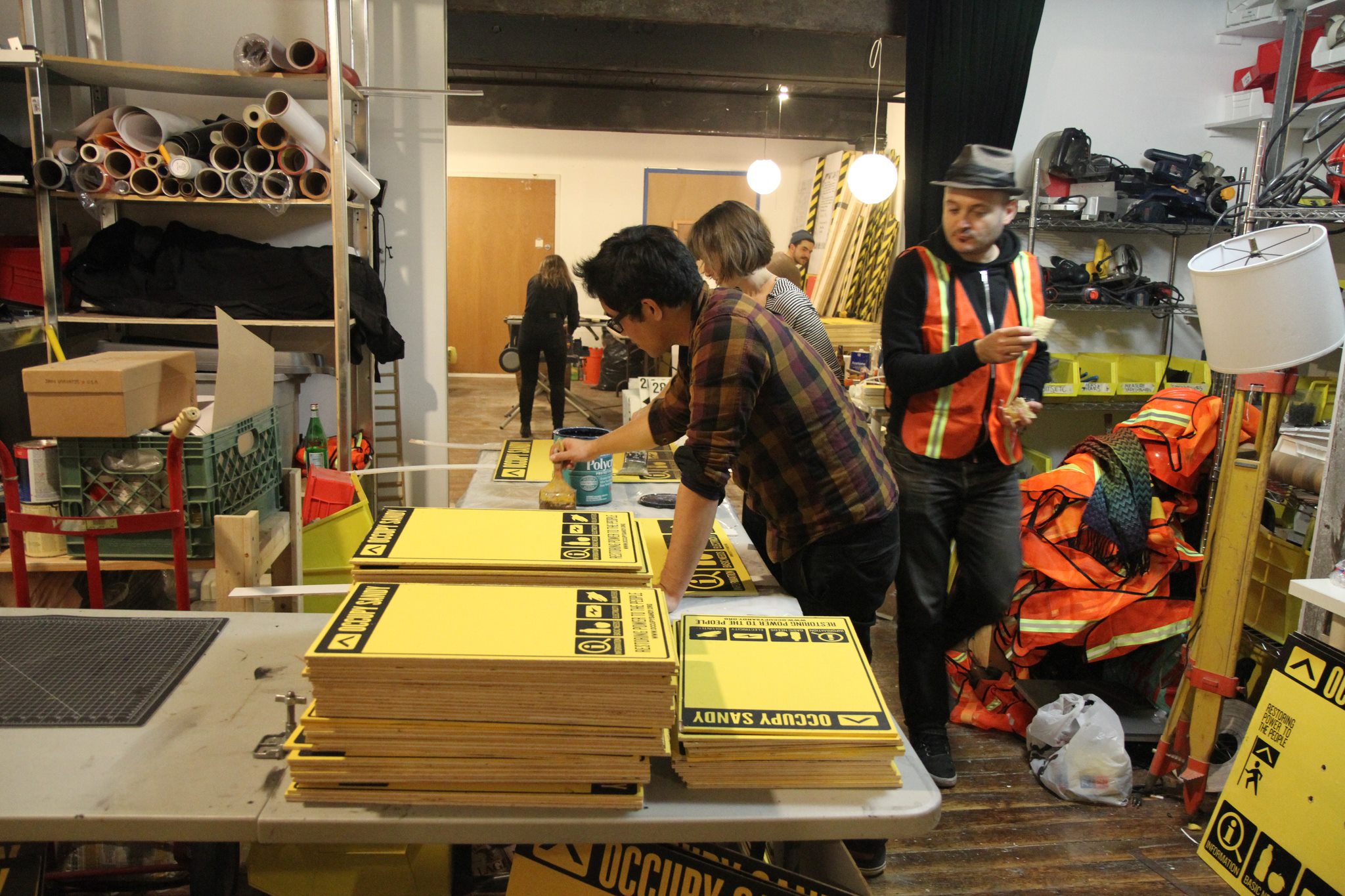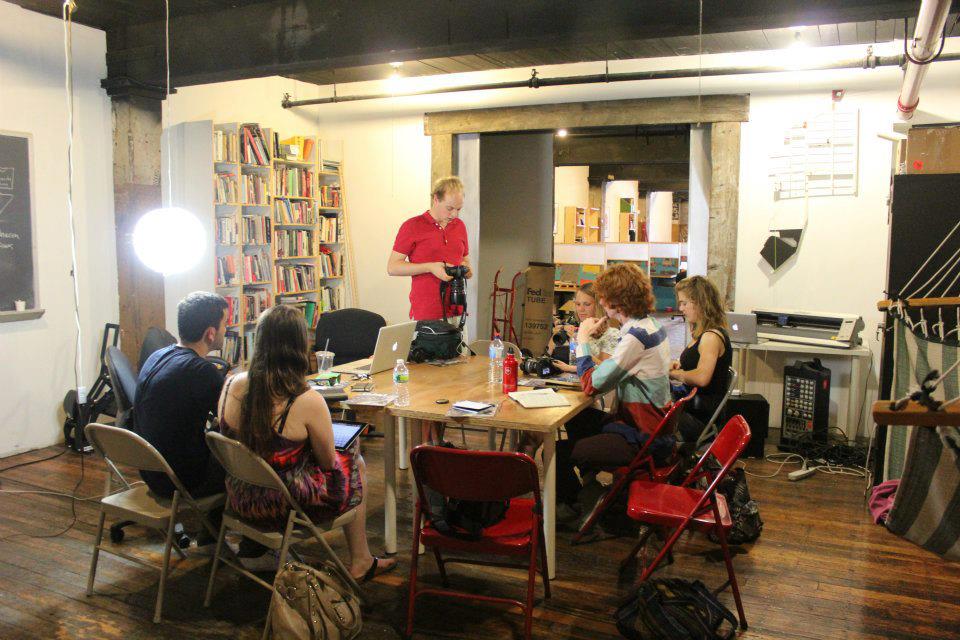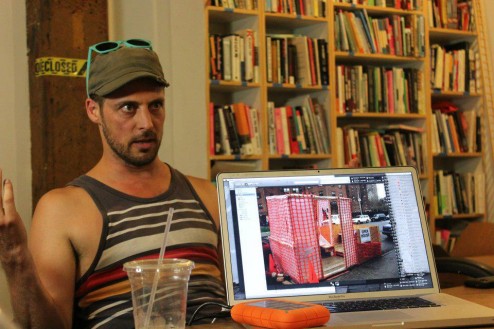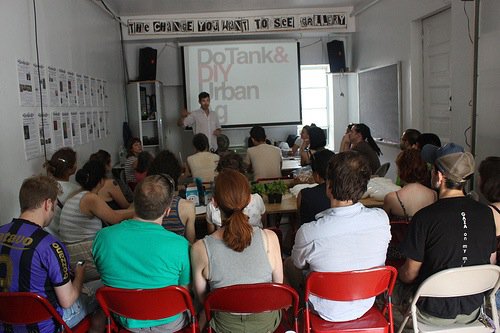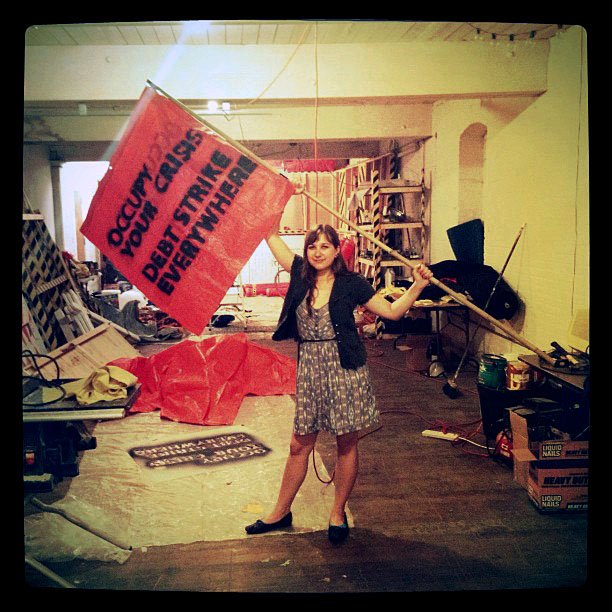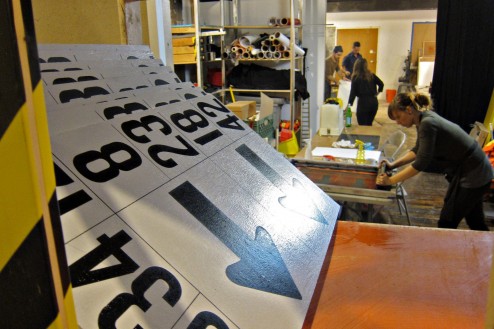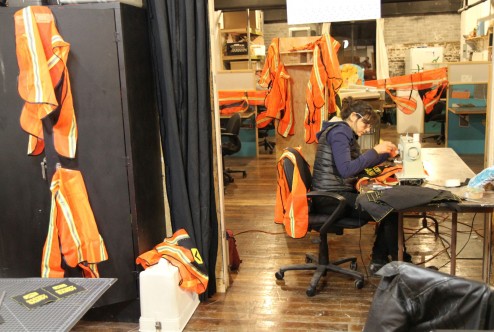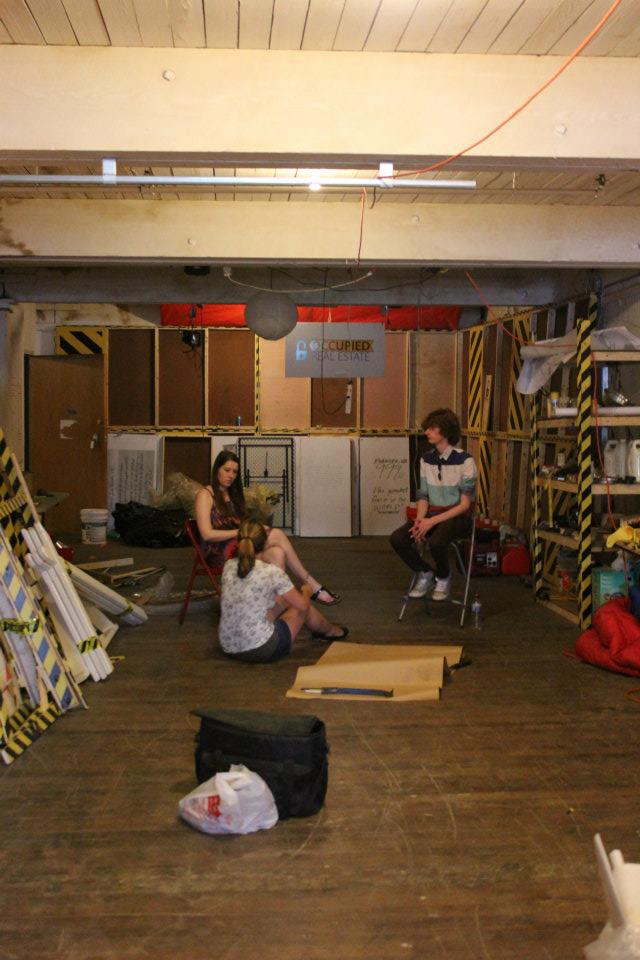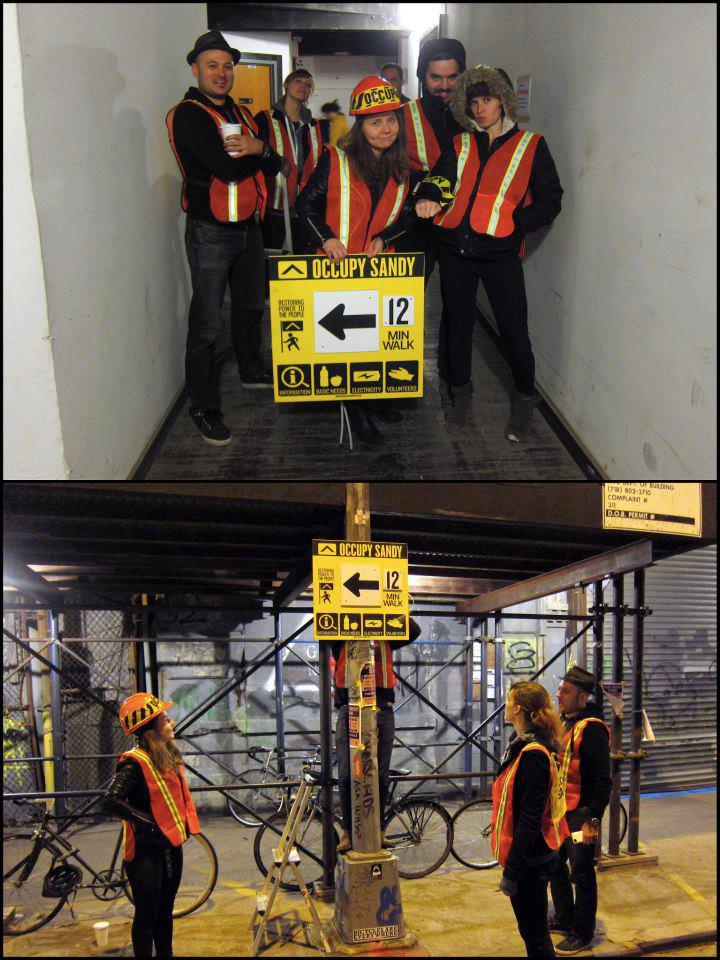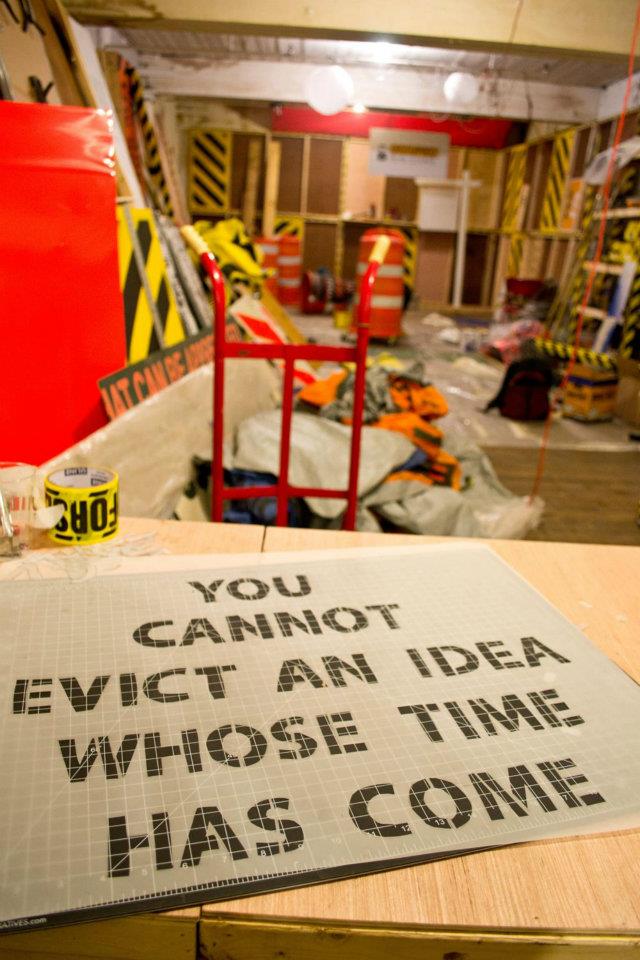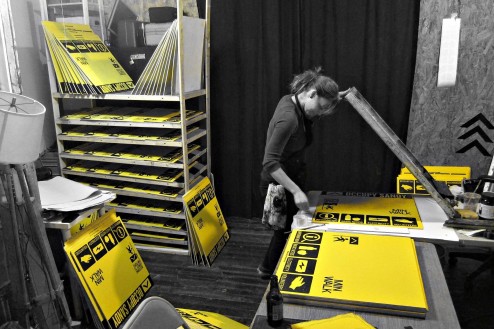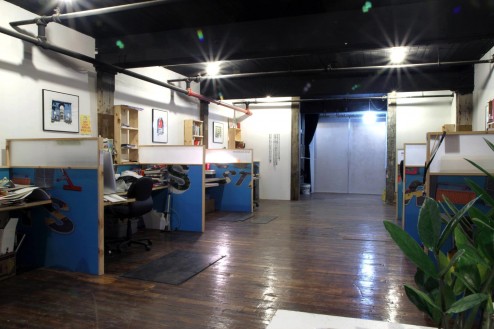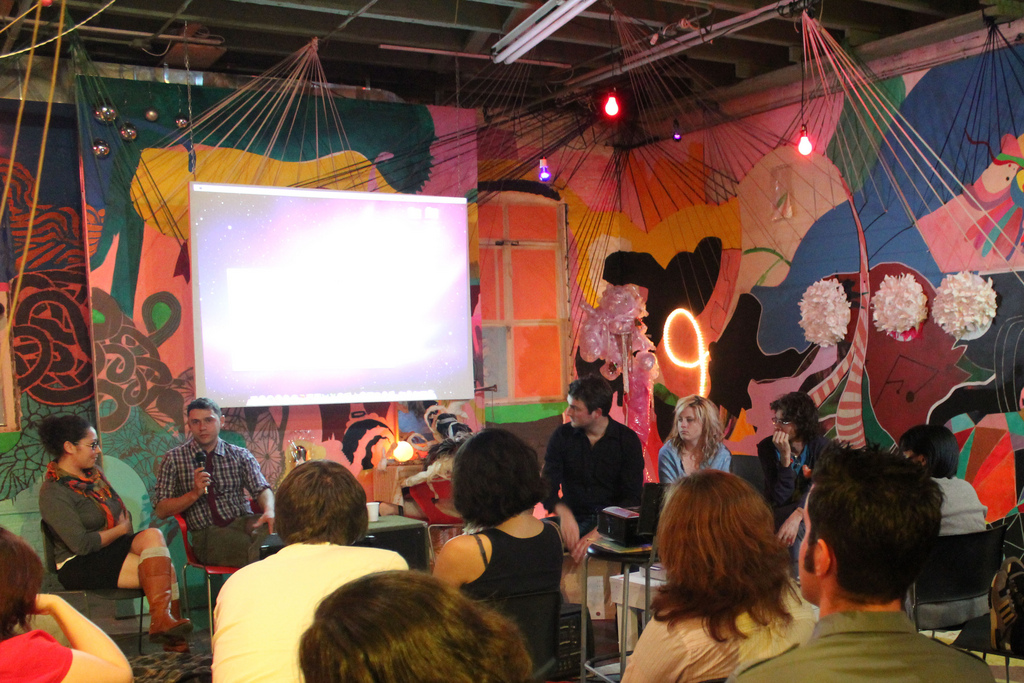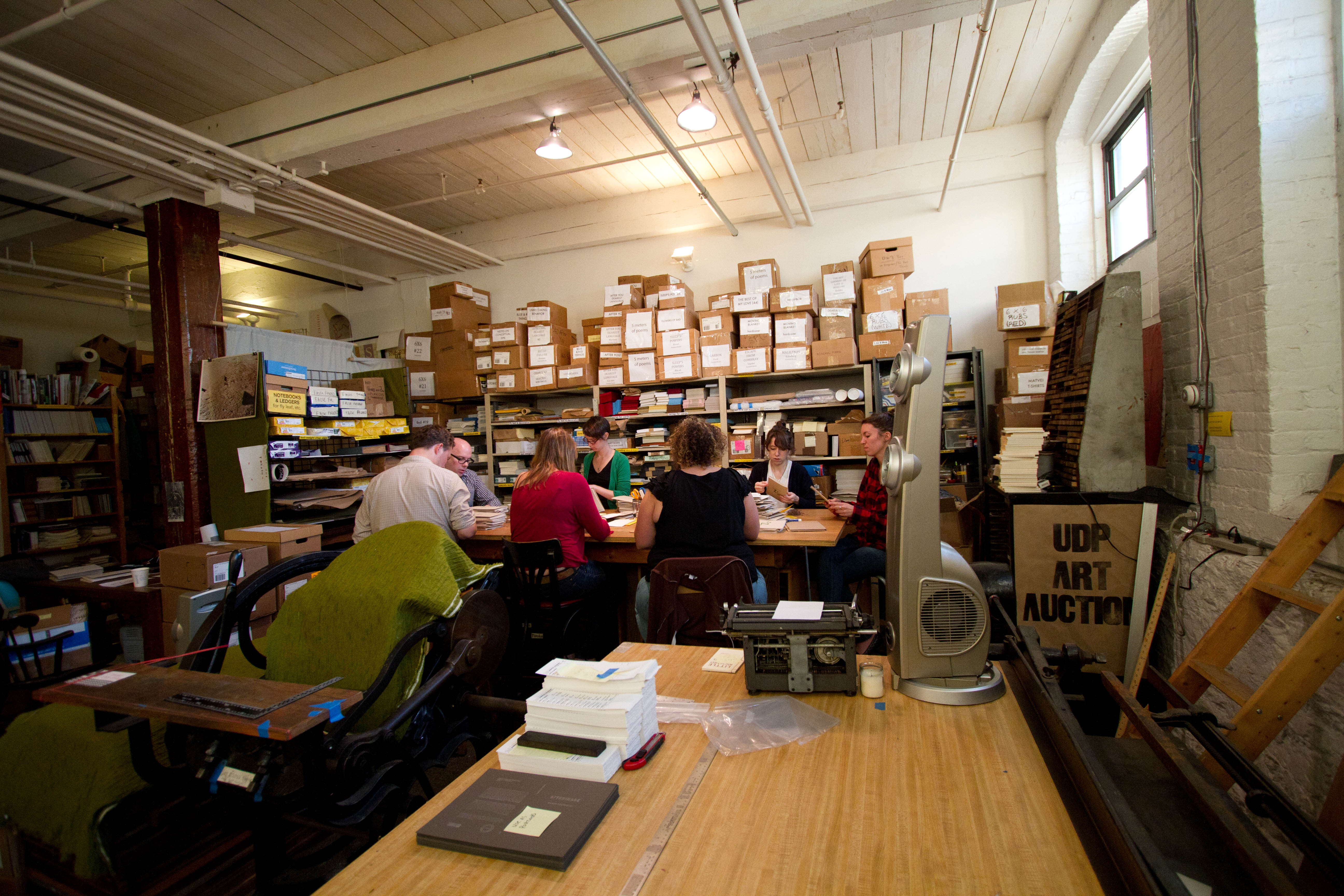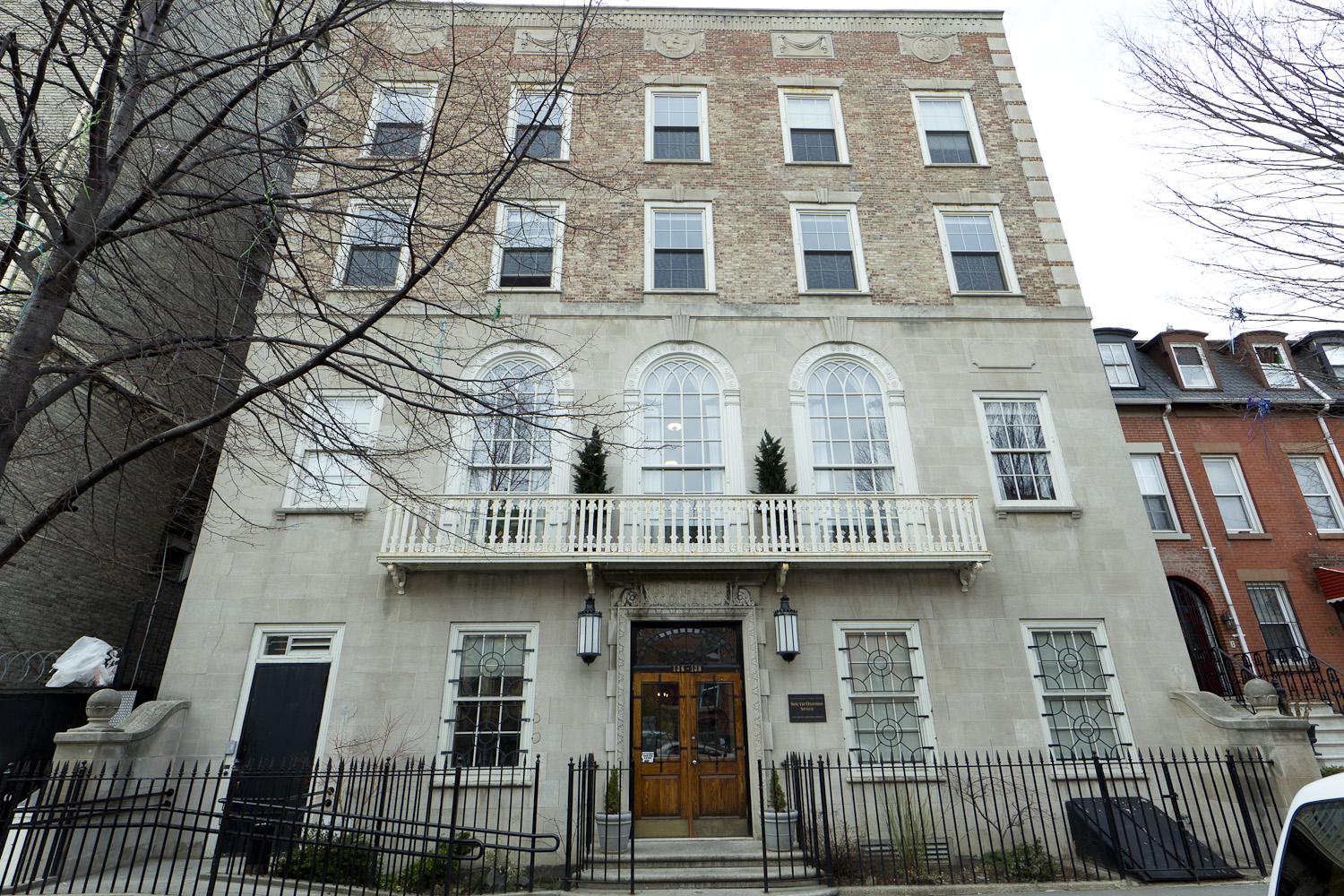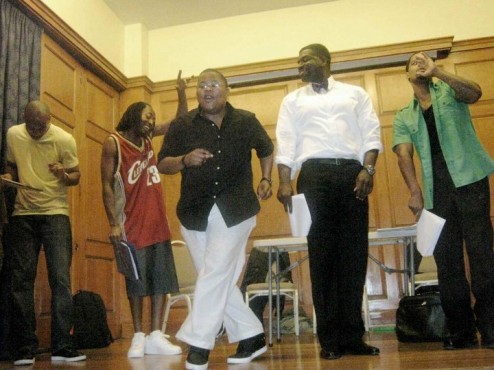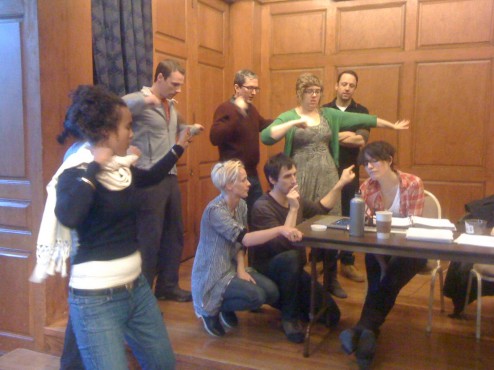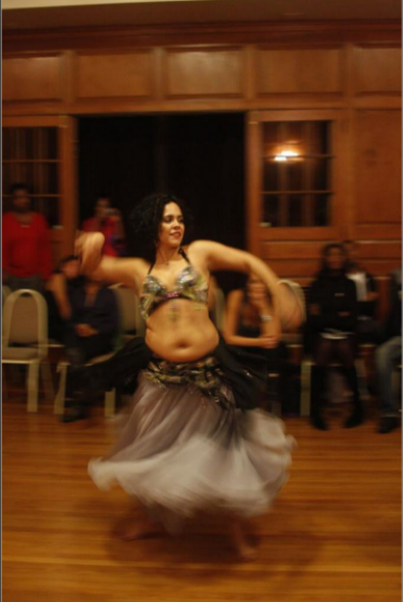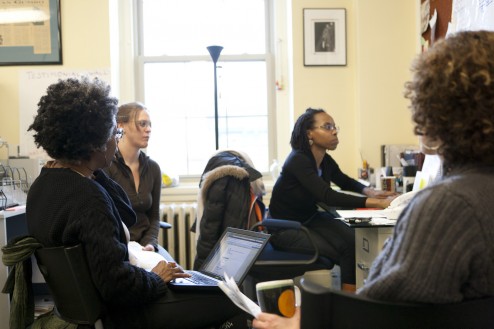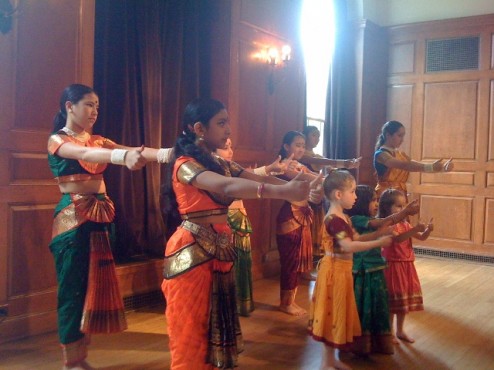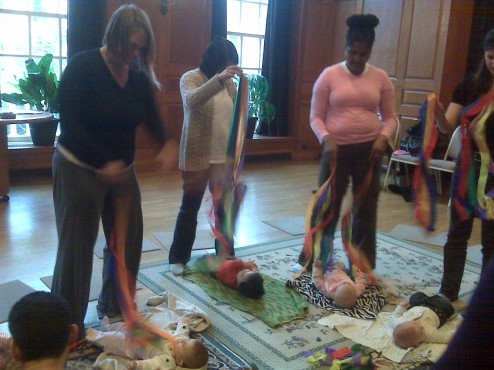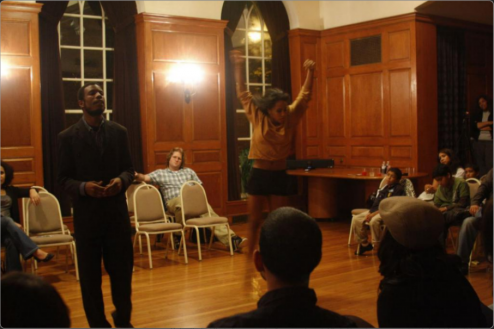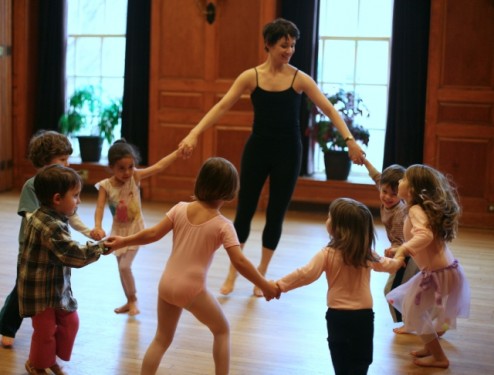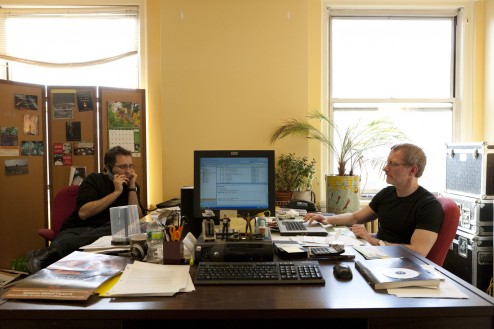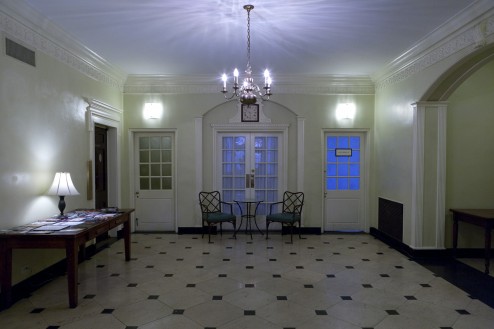neighborhood: long island city | space type: art collective, nonprofit | active since: 1994 | links: website, facebook, twitter
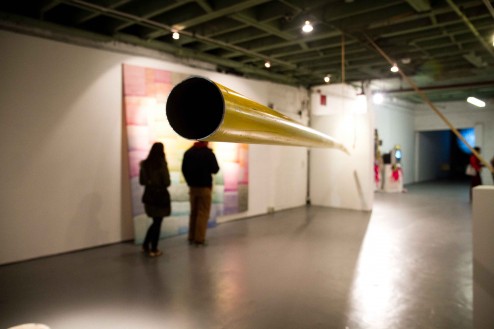
all photos by Maximus Comissar (unless noted)
Yes, I know Flux Factory is in Queens. For what it’s worth, they actually started in Brooklyn—in the Monster Island building—and they’re one of the longest-running art collectives currently active. More importantly, though, they are, individually and as a group, terrifically creative, sensationally ambitious, and just unbelievably fun. I change the standards of what I’m going to cover on this site all the time, but the best way to sum it up is this: If I think something is fabulous, I want to cover it. And Flux Factory is fabulous.
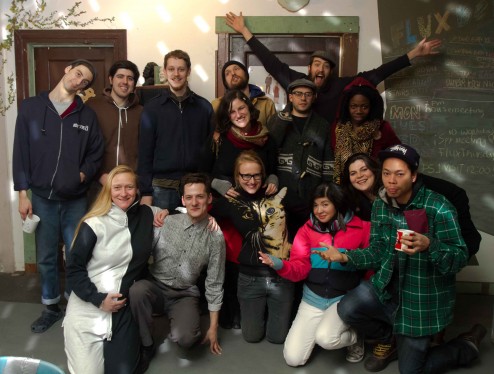
some of the fabulous Fluxers
Housed in a converted greeting card factory in Long Island City, Flux has fourteen art studios and a staff of six. That’s around twenty people give or take, and in 2011 they held seventy-five different events (here’s a sampling), including art shows, installations, performances, screenings, workshops, lectures, and more. Everything at Flux is done, per their mission statement, with a “rigorous commitment to the collaborative process.” They have four major thematic group shows each year, involving art, performance, and community events, utterly transforming the gallery space each time. Recently there was “iSpy,” a “participatory collaborative game show” that encorporated guessing games, livestreaming, piñatas, feminism according to World of Warcraft, and tweets from the Flux toilet whenever it was flushed. Before that was “Banquet for America,” a month-long extravaganza that saw the gallery redone as an entire village, with a fifty-foot banquet table-cum-catwalk down the center and each artist manning his or her own shop, “selling” things like donuts and haircuts and feminist karaoke (I meant to sing “I Will Survive,” but I ran out of time). In addition, there are dozens of smaller projects, including educational initiatives, resident solo and group shows, guest-curated projects, Flux Radio, and a monthly potluck. There was a death match debate to discuss how artists are interacting with the #OWS movement. There have been lectures on social hijinx, interviewing skills, and kayak-building.
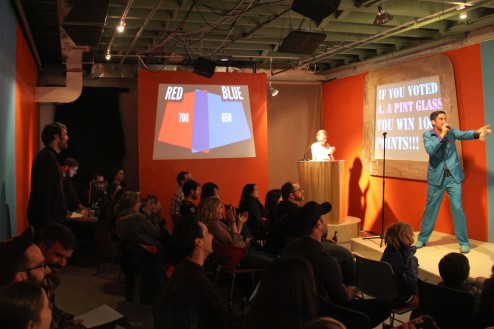
iSpy
Have I given you a sense of the incredible creativity and diversity of the artists in this group? This is why we live in New York, you guys, or at least why I do: to be able to see and participate in this kind of expectation-thwarting, envelope-pushing, rambunctious creative glee. And listen: the Fluxers are always looking for new friends, new volunteers, and new collaborators, so please, go on up to Queens and check them out. But first check out my interview with Executive Director Christina Vassallo, Residency Director Douglas Paulson, Press & Curatorial fellow Georgia Muenster, and artists Jason Eppink, Adrian Owen, and Richard Nathaniel.
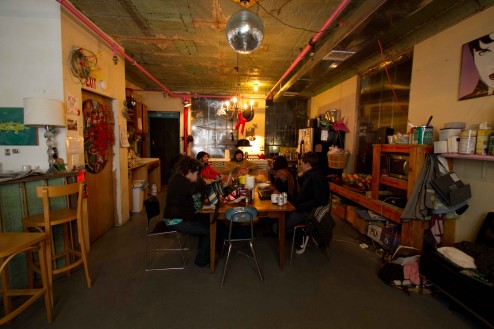
brooklyn spaces: Is there a unifying theme among the artists here? How do you decide who gets to have a studio?
Christina: We’re not focused on a specific genre or discipline. It’s really people who are interested in working collaboratively; that’s our main criteria.
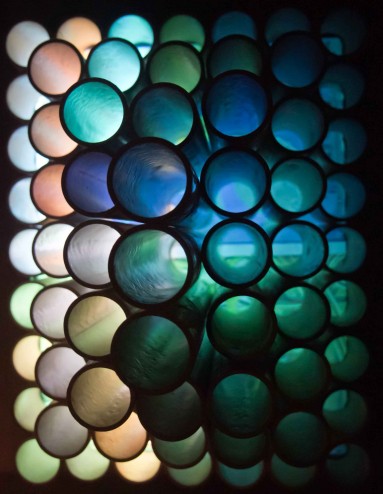 Douglas: Flux is an intentional community, and we rely on consensus-based decision making. The artists choose the next residents, conceptualize and generate the work for the shows, figure out who’s doing the chores. We discuss everything, and everyone has the right to object or bring new terms. Of course, there’s never unanimous agreement on anything, but after a discussion, the people who might not necessarily agree at least feel like they’ve had a chance to be heard. One thing that comes up a lot is the idea of “fluxiness,” which is a word we all know but no one can actually define. It’s the way we describe whatever it takes for someone to endure being part of this crazy mess.
Douglas: Flux is an intentional community, and we rely on consensus-based decision making. The artists choose the next residents, conceptualize and generate the work for the shows, figure out who’s doing the chores. We discuss everything, and everyone has the right to object or bring new terms. Of course, there’s never unanimous agreement on anything, but after a discussion, the people who might not necessarily agree at least feel like they’ve had a chance to be heard. One thing that comes up a lot is the idea of “fluxiness,” which is a word we all know but no one can actually define. It’s the way we describe whatever it takes for someone to endure being part of this crazy mess.
Adrian: I think it’s wrapped up with the idea that we often take on ambitious projects that we’re not quite sure how we’re going to do and then figure it out as we go.
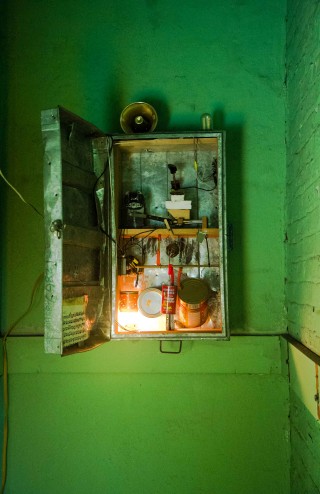 Georgia: Fluxiness to me is a cross between ingenuity and impossibility. And the color green.
Georgia: Fluxiness to me is a cross between ingenuity and impossibility. And the color green.
Adrian: We want to make sure we’re perceived as professional as well as fun. So that’s part of fluxiness too, knowing that we have the heads behind all these crazy things we’re trying to do.
Jason: Yeah, but also? Fuck professionality. I think it’s more being able to execute what you can and pulling it through somehow. A lot of our peers don’t execute at the level we do. We actually make shit happen.
Georgia: We do so so so much. It’s kind of preposterous how much we do.
Adrian: Getting a fully functional administration rolling has allowed us to produce so much more.
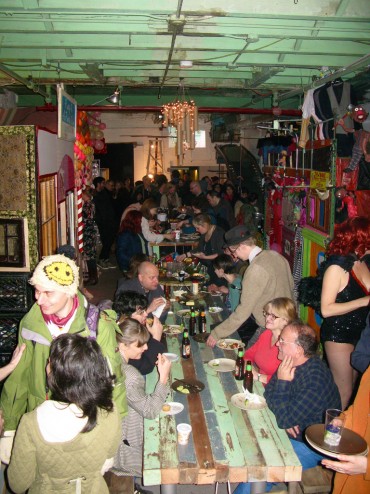
Banquet for America
brooklyn spaces: Do you find any conflict between the organization required and the creative space of doing these sorts of projects?
Adrian: Yeah, that’s what we’re navigating all the time. It’s like herding cats trying to organize artists.
brooklyn spaces: Jordan from Silent Barn said exactly the same thing about musicians. Tell me about a favorite event or exhibit you’ve seen or been a part of here. I came to the opening of “Banquet for America” last month, and it was absolutely incredible.
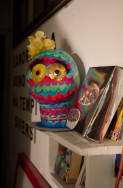 Christina: That show was particularly fluxy in that it required extensive participation from the artists and the audience, with all the artists’ shops and performances. The more serious side of the show was an anti-capitalist statement about how mom-and-pop shops and independent retailers are getting pushed aside by big-box retail stores. Another show I loved was “Sea Worthy,” which, in typical Flux fashion, experimented with the boundaries of what an exhibition could be. It was in conjunction with the Gowanus Studio Space and EFA Project Space, and Swimming Cities contributed as well. We paired artists with boat builders to make a whole flotilla of artworks, and we brought members of the public around the New York City waterways. Again there was a serious discussion beneath the presentation: The water is the largest open space in New York City, and we wanted to show people that there are ways we can reclaim it.
Christina: That show was particularly fluxy in that it required extensive participation from the artists and the audience, with all the artists’ shops and performances. The more serious side of the show was an anti-capitalist statement about how mom-and-pop shops and independent retailers are getting pushed aside by big-box retail stores. Another show I loved was “Sea Worthy,” which, in typical Flux fashion, experimented with the boundaries of what an exhibition could be. It was in conjunction with the Gowanus Studio Space and EFA Project Space, and Swimming Cities contributed as well. We paired artists with boat builders to make a whole flotilla of artworks, and we brought members of the public around the New York City waterways. Again there was a serious discussion beneath the presentation: The water is the largest open space in New York City, and we wanted to show people that there are ways we can reclaim it.
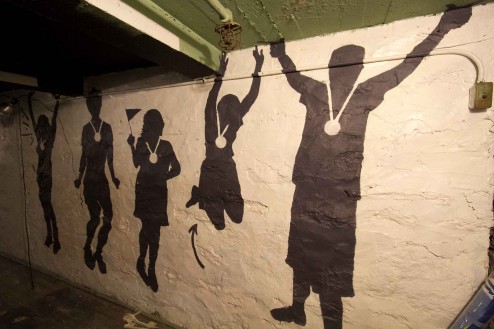 Douglas: One of my favorites was “Congress of Collectives.” It was completely different from these sorts of spectacle-heavy shows. We invited representatives of more than thirty collectives from the U.S., Europe, and the Middle East, and we set up projects, discussions, panels, and talks designed to explore what it means to work collectively.
Douglas: One of my favorites was “Congress of Collectives.” It was completely different from these sorts of spectacle-heavy shows. We invited representatives of more than thirty collectives from the U.S., Europe, and the Middle East, and we set up projects, discussions, panels, and talks designed to explore what it means to work collectively.
Georgia: One of my favorites was “Going Places (Doing Stuff),” our bus tour series, where you’d get on a bus and not know where you were going.
Jason: That’s what I was going to say too!
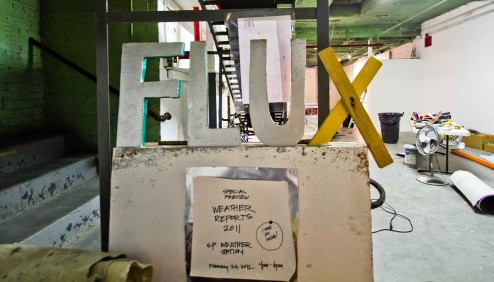
brooklyn spaces: I didn’t know that was a Flux project. Where were some of the places that you took people?
Jason: This was a three-summer project. The first year I went on three of them, and it blew me away, it totally made my summer. I wasn’t part of Flux then, but when I heard they were doing it again, I had to get involved. My friend Matt Green and I led one called “Quest for Immortality.” First we went to visit the Self-Transcendence 3100, which is a 3100-mile foot race around a single city block, started by the late guru Sri Chinmoy. Then we met Ashrita Furman, who holds the most Guinness World Records, and we set our own records, like “most people flossing their teeth with the same string of dental floss at once.”
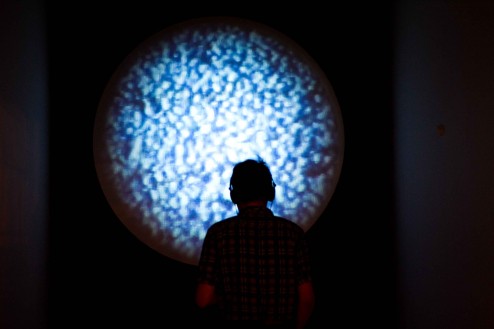 Adrian: I beat some fifteen-year-old girl’s record for speed-eating a bag of Skittles.
Adrian: I beat some fifteen-year-old girl’s record for speed-eating a bag of Skittles.
Jason: Next we went to visit a monument of Crete that this old guy has been building in his yard in Bay Ridge, and then we went to Staten Island and climbed these abandoned liquid natural gas towers. We finished at Lemon Creek State Park, where this guy has been building rock cairns along the beach for about ten years. It used to be this trashy, gross place, and he has completely transformed it.
Adrian: I have two favorite Flux experiences: “The End of the End of the End,” the last show at the previous space, and “Housebroken,” the first show at this one. They were absolute mayhem from a curatorial standpoint, but just so much fun. Every single room had something happening in it at all times. There were like 200 artists involved in each. Every nook and cranny was programmed. It was intense and awesome.
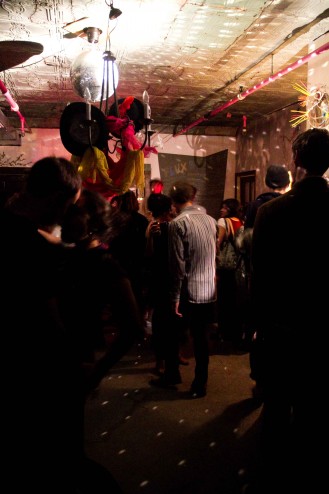 brooklyn spaces: Did you perform or curate or make something for them?
brooklyn spaces: Did you perform or curate or make something for them?
Adrian: My metal band White Limo played both, and at “Housebroken” I sang opera in the shower with the door open and the shower curtain closed, wearing gold trunks. One girl actually pulled back the curtain because she probably thought it was a recording, and she just screamed and ran out.
Jason: Another awesome thing about that show was that everyone was invited to give us something we could keep, as a way to have artists help us finish the space. Most of the artworks that you see around this space came from that show.
Richard: I think my favorite experience is the monthly Flux Thursday. It’s all the people you know and tons of people you don’t, and everybody’s showing work and drinking and talking and high-fiving.
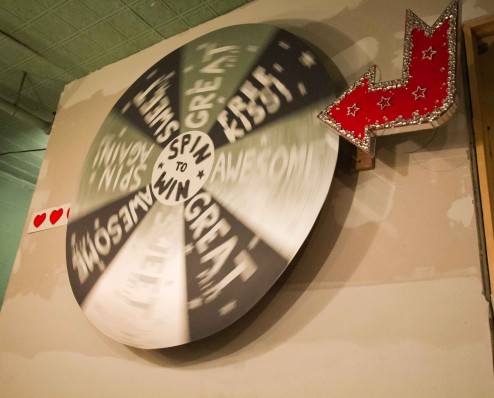 Georgia: Those are potlucks. We love to feed people.
Georgia: Those are potlucks. We love to feed people.
Richard: Also the Greenpeace stuff was dope. We worked with them to sell real estate on top of black coal mountains. Just light stuff, you know.
Adrian: It was the performance-art portion of a project for a coal awareness tour they were doing with one of their Ice Breakers. It was in Chelsea Piers, right next to the driving range. One of our artists got hit by a golf ball.
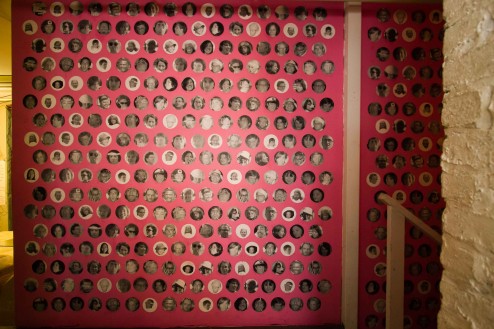
brooklyn spaces: So when an artist has a studio here, is it only about working collectively?
Douglas: No, everyone here is pursuing their individual art and their own career in one way or another as well.
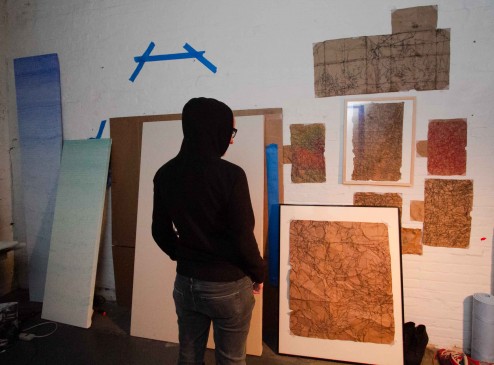 Christina: Through the years we’ve gotten really good at focusing on the collaborative aspects, and now we’re starting to get better at nurturing the individual simultaneously.
Christina: Through the years we’ve gotten really good at focusing on the collaborative aspects, and now we’re starting to get better at nurturing the individual simultaneously.
Douglas: Flux used to be a lot of people in their early twenties who just got out of school, but now it’s older, more serious. We had a Fulbright Scholar here, we have career artists. But we’re extremely conscientious about maintaining the existing community. We’ve dedicated one studio to people who have had a residency here already, so there are always former residents coming back. That’s extremely important, and it’s something that we’ve been very conscious of as we’ve transformed to a formal residency program: how to maintain that kind of cohesive fluxiness.
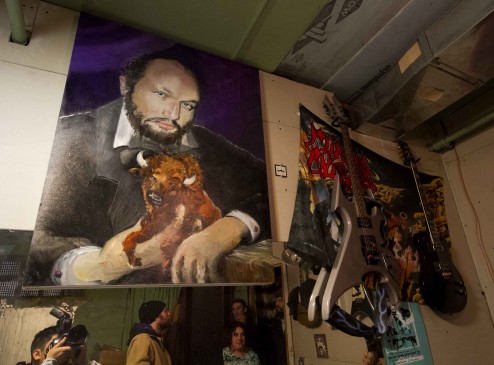
brooklyn spaces: How do you think Flux is affected by being in Long Island City?
Christina: There are so many things we get here that we wouldn’t get anywhere else. If we were in Manhattan we’d just be another group fighting for the same resources and the same eyeballs and audience.
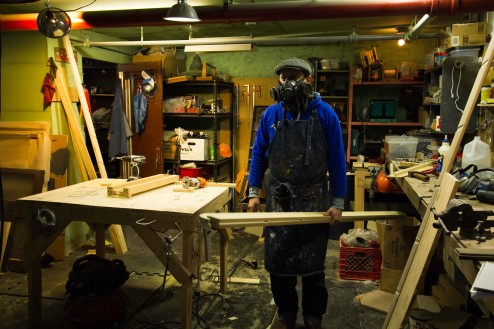 Adrian: It definitely makes it harder to attract foot traffic, though. Queens holds such a stigma—even though it’s easier to get here than to most of Bushwick. It’s like, “Did you say Queens? I don’t know, man.” So that’s a big hurdle.
Adrian: It definitely makes it harder to attract foot traffic, though. Queens holds such a stigma—even though it’s easier to get here than to most of Bushwick. It’s like, “Did you say Queens? I don’t know, man.” So that’s a big hurdle.
Georgia: It’s somewhat absurd to me; there are dozens of arts organizations out in Long Island City. Sculpture Center, Noguchi, PS1, Fisher Landau, Socrates Sculpture Park, Museum of the Moving Image…
Douglas: And the fact that we’re not in Brooklyn has allowed us to make our own identity rather than being just another Bushwick space.
Jason: I feel like if we were in Brooklyn we’d be overrun. I think it’s kind of to our advantage that people think it’s not as easy to get here. The people who want to get here, get here. It’s already an awesome, big community.
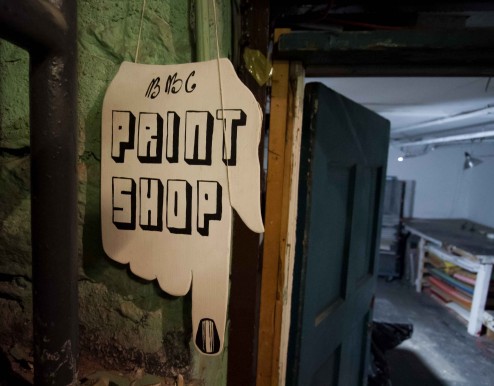 Adrian: We’re starting to get a few relationships locally. We’ve been here long enough, and people are starting to figure out what we’re up to.
Adrian: We’re starting to get a few relationships locally. We’ve been here long enough, and people are starting to figure out what we’re up to.
Jason: I love that the people from the neighborhood see us as these crazy art people. We get to be that for a lot of New York. My first experiences of Flux were like, holy hell. This is much better than art. It’s wacky and playful people doing really exuberant things. I actually think that gets back to what fluxiness is. I think that’s sort of our legacy.
Adrian: I totally agree. That’s exactly what happened to me. I had a friend who lived in Queens and I was like “What? I’m not going over there.” And then Flux asked my band to play, so I made the trek—and I’ve been here for seven years. My eyes were opened in a whole new way. I was like, “You can do this?”
Georgia: It’s the same story for me too. The sense of playfulness is just unmatched anywhere else.
Jason: There’s no context for this sort of stuff in mainstream culture. To be exposed to this happening? It’s amazing.
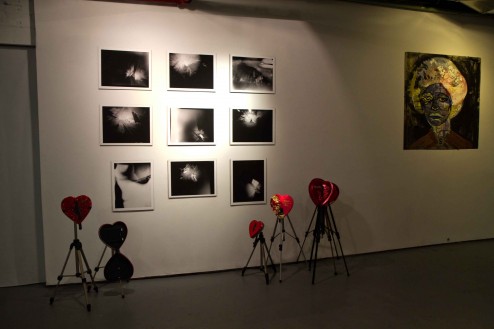 ***
***
Like this? Read about more art collectives: The Schoolhouse, Rubulad, Swimming Cities, Monster Island, The Hive, Arch P&D, Silent Barn
